Displaying items by tag: Enda O'Coineen
Irish Solo Sailor Enda O'Coineen Third in Debut IMOCA Transatlantic Race
Irish solo sailor Enda O’Coineen has finished third in a 3,400 mile non–stop Transatlantic race from the Carribbean to France.
In an exceptional performance, Ireland’s Enda O’Coineen aboard his IMOCA 60 Currency Kilcullen Voyager completed the podium in the IMOCA Ocean Masters Transat St Barth-Port la Forêt, the third event of the IMOCA Ocean Masters World Championship 2015-2016.
Kilcullen crossed the finish line off the Breton harbour at 13:19:55 today (Sunday, 20th December), with a race time for the 3375 mile course of 13d 22h 19min 55s. In fact O’Coineen was forced to start the race just over a day later than the rest of his competitors after his boat experienced problems with her engine’s saildrive unit. As a result the actual elapsed time for Currency House Kilcullen’s passage across the North Atlantic was 12d 21h 49m and 55s, less than the 12d 23h 57m and 42s time of second placed Fabrice Amédéo who arrived yesterday on Newrest–Matmut.
“My hair is wet from a magnum of champagne - it was a great arrival,” said Kilcullen’s jubilant 60-year-old skipper after he’d docked in Port la Forêt. “I could have got here sooner, but when I realised I was under no pressure I took the last two days easy, rather than trying to catch the other boat.”
While there were seven starters, the race has been a war of attrition thanks to the severe winter gales, which have frequently brought storm force gusts to the fleet over the last week. At present only one boat is left on the race course – Morgan Lagravière’s Safran which was around 870 miles astern when Currency House Kilcullen finished this afternoon.
During one gale early last week, O’Coineen said he saw 46 knots of wind and he experienced similar gusts once past the Azores islands on Thursday night. “You are humbled by that ocean out there. It is an animal! I don’t think the storms are getting any easier with globe warming - some of those storms were outrageous. You got used to the wind being ‘only 30 knots’, all the time,” recounted O’Coineen. He paid tribute to the boat that British round the world veteran Mike Golding sailed to sixth place in the 2012-3 Vendée Globe: “She is a great boat - very well thought out. I think she is easier to sail than some of the other boats. The keel and self-steering are all in great shape.”
The only issue were some sails, which O’Coineen admitted were destroyed due to him pushing too hard early on. “I sailed the boat quite aggressively, because I really wanted to catch up, but probably too aggressively because after four or five days in fairly quick succession, I blew out the A7 and the J2 sails.”
He expended a lot of energy recovering and dropping the broken sails forcing him to have a quiet day to recuperate. “I got back into the race again and got a bit more confident. All I wanted to do was finish, so to be in a podium position is a fantastic result for me, who is a gifted amateur with a day job. I think age does add a certain factor - you have the benefit of experience…and then there’s luck.”
The result of having taken it relatively easy over the last couple of days while the wind has been ‘only 20 knots’, O’Coineen was in good shape when he arrived in Port la Forêt.
In completing this race, O’Coineen and Kilcullen have now qualified themselves for the 2016-7 Vendée Globe, but O’Coineen says he hasn’t made up his mind if he is doing the famous singlehanded non-stop around the world race which leaves next autumn from Les Sables d’Olonne, France: “I am taking it in stages and this is the first stage. I am having serious meetings with myself and myself! It is a very personal thing, another stage in life. But now it is nice to know it is an option.”
If he did do the Vendée Globe, O’Coineen would be Ireland’s first ever entry in the race which over the years in the UK has made sailing stars out of Ellen MacArthur, Sam Davies, Alex Thomson and Brian Thompson among others.
O'Coineen scored the podium position in the IMOCA Ocean Masters Transat St Barth-Port la Forêt race sailing singlehanded across the Atlantic in Mike Golding's Ecover/Gamesa IMOCA 60.
Racing across the North Atlantic in December was no walk in the park and Enda and his boat had to endure repeated storms and 45-50 knot winds.
O'Coineen is the Irishman to have a good crack at the IMOCA class, taking third on his debut race.
After starting 24 hours behind the fleet due to technical difficulties, Enda in his 60–foot IMOCA yacht trailed the leaders by over 300 miles before making a remarkable comeback.
The fleet of seven almost identical yachts was repeatedly hit by winter storms, facing winds of over 90kph and massive sized waves. One skipper had to be airlifted off his boat due to injuries he sustained. Three others had to stop to make emergency repairs in the Azores following damage.
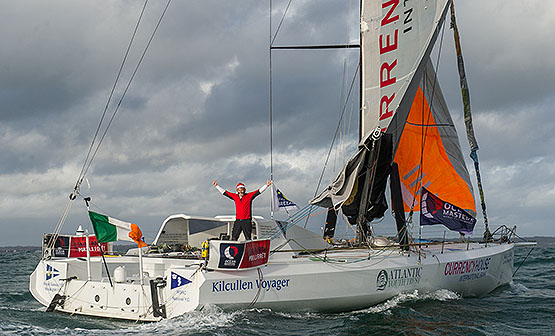
Speaking about the race Enda said:
“Over the years I have crossed many oceans in yachts and inflatables much smaller than this, yet this has been the most physically and technically testing race I have ever entered. Sailing these boats alone is a test of literally every skill imaginable. From stitching sails, working on engines, cooking in 20ft swells, to having no more than a few minutes consistent sleep at a time, the past two weeks have tested me beyond imagination."
"It is fear, the adventure, the unknown, and the scale of the challenge that attracts me to this extreme end of the sport. Most of my competitors are 20 years my junior but that only makes me even more determined. The objective was simple, to finish, and in turn qualify for the Vendee. To finish 3rd is remarkable but only possible due to the misfortune of my fellow competitors as they suffered gear failures."
O'Coineen will now rest and look forward to 2016 and the possibility of racing solo around the world in the Vendee Globe.
O'Coineen's Kilcullen Voyager Moves Into Third Place in Transat Race
Having started a day late and trailed the fleet by 300 miles, debut Irish IMOCA 60 skipper Enda O'Coineen has moved up into third place as the seven boat fleet pass the Azores. O'Coineen now has a potential finsih time of as soon as this Sunday.
The fleet leader, Sebastien Josse, is already finished with a dominant display. On crossing the finish line off the Linuen Est mark, at the entrance of Port la Foret harbour, this Wednesday 16 December, at 20hr 18mn 17s GMT, the skipper of IMOCA60 Edmond de Rothschild won the transatlantic race in style after dominating proceedings from beginning to end, only giving up the head of the race for the first six hours to SMA skipper Paul Meilhat.

His race time is 10d 05hr 18mn 17s. and his average speed along the great circle route (3,375 miles) equates to 13.76 knots. He covered some 3773 miles over the ground at a speed of 15.38 knots. In so doing, he qualifies for the Vendee Globe 2016.
Meanwhile, on Kilcullen Voyager, O'Coineen sent Afloat.ie the following update:
Being honest, I was scared. Through the early morning, it blew up to 40 knots – I ran off before it. The waves trundled after us, sometimes as high as double-decker busses and predictable like the 7A - However it’s the odd rogue wave, against the flow - that catches you unaware.
Eventually last night’s storm abated. I dozed off to sleep and awoke about 90 minutes later. The miserable grey dawn had arrived - like a black and white movie – now the days are so short they morph into the night that it's hard to tell the difference. The wind had dropped back to 15 knots. Like getting a thrill being the very last on a plane, or doing something that’s against the rules - its living on the edge which brings the kicks - and somehow I am not sure if that’s healthy, even if I have survived, so far as my hairs get greyer.
This morning, I had three tasks on sunrise. Which order was the issue. One being my ritual bow of porridge, the other a sail change and a the third to have a dump - though the least said about this the better. However I should reference one, seldom mentioned fact - which in my humble view has revolutionized ocean racing – it is the arrival of the biodegradable plastic bag and wipes – not invented when I was a lad.
Anyway, I went for the sail change first. This involved dragging the large headsail on deck and other preparations. Then when ready to go I had my porridge – which was just as well, since within an hour the wind was backup to 25 knots plus, so I abandoned the sail change.
Now my mood has moved to survival. Not much succour for romance and poetry. Overhead the rain pounds like pellets, I have never seen as much in one dump from the heavens. From tropics, through autumn and now winter, we have had three seasons in 10 days - so Spring must be just around the corner? Could it be Port La Foret?
Rankings on 16 December at 22h (UTC) and ETAs in Port-la-Foret
1. Edmond de Rothschild, Sebastien Josse: Finished on 16 December 2015 at 21h 18' 17" - Winner in 10 days 5h 18' and 17"
2. Newrest / Matmut, Fabrice Amedeo, 818.3 nm. ETA potentially Saturday 19/12 am
3. Currency House Kilcullen, Enda O'Coinnen, 1098.0 nm. ETA potentially Sunday 20/15
4. Le Souffle du Nord, Thomas Ruyant, 1128.4 nm
5. O Canada, Eric Holden, 1190.2 nm
6. Safran, Morgan Lagravirre, 1210.5 nm
Abd. SMA, Paul Meilhat
O'Coineen's IMOCA 60 Kilcullen Voyager Makes Gains in Transat Fleet
He started with a 24 hour disadvantage due to engine problems but after a week at sea Irish solo sailor Enda O'Coineen has hauled himself back into the Transat St Barth – Port la Foret race and now trails the fleet by only 55 nautical miles. In seventh place, the Galway Bay sailor is closing in on Canada's Eric Holden. It's been a great debut performance for the IMOCA 60 Kilcullen Voyager and it looks like there will be more gains for the Irish yacht due to the injury of the fleet leader. Paul Meilhat is currenlty awaiting airlift by helicopter.
Yesterday, Meilhat was seriously injured during a manoeuvre. At the time, IMOCA60 SMA was sailing downwind under mainsail alone and two reefs, around twenty miles to the south-west of the Azores archipelago, in 50 knots of wind and 8 metre waves. Paul immediately contacted his team to alert them about the incident: he has pain in the ribs, the hip and the right leg.
Race Management for the Transat Saint-Barth / Port La Forêt and the MRCC in Ponta Delgada (Maritime Rescue Coordination Centre) were alerted straightaway. Initially, Paul and his team decided to find 'shelter' for the boat in the lee of the island of Sao Miguel.
At 15:30 GMT, when Paul confirmed that he was having considerable difficulty moving himself around the boat, the emergency services were triggered. The patrol boat from the Portuguese navy, Viana Do Castelo, heads to the zone. However, the weather conditions are such that it is not possible to envisage an airlift by helicopter or a vessel to come alongside in the immediate future.
SMA is currently barepoled and is drifting offshore at around 6 knots, escorted by the navy patrol boat, which will remain alongside him throughout the night. Paul is in permanent contact with his team and with the medical department in Lorient, Brittany.
Today, Tuesday, once the low currently plaguing the zone around the Azores has shifted over to the East, the weather conditions will improve and Paul can be airlifted by helicopter. SMA's team is on its way and will be in Sao Miguel at around lunchtime local time tomorrow, Tuesday.
French Solo Sailor Aims For Atlantic RIB Record
#Solo - French sailor Christophe Maupaté aims to follow in the wake of Ireland's own Enda O'Coineen in his attempt to be the first person to cross the Atlantic solo from Bordeaux to New York by RIB.
The Figaro veteran will set off on 16 July 2016 from Bordeaux heading north, via the Celtic and Irish Seas – including a stop-over in Dun Laoghaire – on an epic voyage that will see him trace a semi-circle around the North Atlantic.
That route takes Maupaté via the Orkneys, Iceland and the southern tip of Greenland to Canada's Maritimes provinces and onward to New York to coincide with a commemorative voyage by a replica of historic French general Lafayette's ship Hermione.
And he'll be doing it all single-handedly in a 7.5m RIB, a custom French-built Zeppelin, equipped with a Suzuki four-stroke outboard motor and Garmin navigation and communication devices.
The Atlantic has been crossed by RIB several times before, most notably by TV adventurer Bear Grylls and team in 2003 from Canada to Scotland, and more recently by the Brown brothers from Florida to London in 2009.
But the closest anyone's come to a solo RIB crossing was Enda O'Coineen, when he helmed the 5.5m Zodiac RIB Kilcullen III from Halifax in Nova Scotia to Dunmore East in the mid 1980s – a voyage recounted in his book The Unsinkable Kilcullen.
There is no Guinness World Record for O'Coineen's feat, so Maupaté aims to be the first into the books with his own incredible expedition of some 4,460 nautical miles.
More details can be found on the official Bordeaux -> New York in Solitare website HERE.
24 Hour Race Set Back for Enda O'Coineen
More than 24 hours after the IMOCA 60 masters fleet departed St. Barts in the Caribbean, Enda O'Coineen has started the Transatlantic race and lies some 300 miles behind the race leader.
O'Coineen had to repair a faulty sail drive delaying departure of the Irish yacht, Kilcullen Voyager. Under rules of the race O'Coineen availed of a race condition that permits entrants to start within five-days of the official start time.
The solo Irish sailor will race from St. Barts to Port La Forêt, a distance of 3,400 miles across the Atlantic. Race tracker here
The Galway sailor was not the only boat battling setbacks. Forced to abandon the idea of participating at all is Frenchman Yann Eliès who will now deliver his boat back to his home port of Lorient instead of racing across the Atlantic.
Press release from Enda O'Coineen below:
We can do the Impossible, but Miracles take a little longer
Monday 7th, 0830 hrs Currency House Kilcullen departed St Maarten for St Barths and successfully joined the race. This is in accordance with the rules that allow entrants to start within 5-days to allow for unforeseen events such as the one Currency House Kilcullen encountered.
On Wednesday 2nd December the team left St Maarten for St Barths. While hoisting the mainsail the Sail Drive unit ceased working.
Later it transpired that the sail drive was not serviced and reassembled properly. It had hardly been used since departing Gosport in October.
With Mike Stark, CEO of Currency House Bank on board, his first voyage on the vessel, it was disappointing but he was philosophical. And in the spirit of the event, under sail only, the yacht made it to St Barths and completed the pre-race scrutinising. There were few outstanding requirements requested, including propulsion...
The Sail Drive on these yachts is a custom built part so fixing it was not going to be easy. In fact some said it was impossible.
Parts suppliers in Croydon were mobilized, traffic congestion on London’s M25, was overcome, and transatlantic flights caught. Jay Vahey an English-Irishman dropped everything and flew from Portsmouth, Pete Durkan aeronautical engineer and skilled fabricator made a custom part. Merf Owen the original designer of the yacht was involved and an amazing West Indian mechanic (Carl), a crane company owner (Percy) IYS and an electronics specialists (Andrew Rapley) all supported the team at marinas led by Brian Dehler with a positive ‘can do’ nothing is impossible approach. Teamwork and problem solving at its best.
Having completed emergency repairs, the Skipper has declared his confidence in the yacht and preparations and is very appreciative to everyone for their massive support. Speaking about the last week Enda O’Coinnen said:
“While I am on my own at sea, its a massive team effort and I am really appreciative of the support of Currency House Bank and everybody who has pitched in. Murphy’s Law was in action where ‘What Can Go Wrong - Will Go Wrong’, - and Murphy was an optimist - seemed to be to rule since arriving in St Maarten.”
Now Enda must focus on the race, a simple sail across the Atlantic during December.
Green Dragon's Enda O'Coineen To Compete in IMOCA Ocean Masters
The former Chairman of the Green Dragon Irish Volvo Ocean Race entry is taking the helm of an ocean racer himself.
Galway Bay's Enda O'Coineen is one of eight IMOCA 60s due to compete in the IMOCA Ocean Masters Transat St Barth-Port la Foret. This eastbound transatlantic race sets sail from the French Caribbean island of St Barth this Sunday, 6th December, bound for the Breton short-handed sailing capital, Port la Foret in France, 3,400 miles away.
Afloat.ie readers will recall O'Coineen (60), who acquired the 60–foot monohull earlier this season and berthed her in Dun Laoghaire was due to compete in this June's Dun Laoghaire to Dingle race but did not start. He raced the IMOCA 60 in Cork Harbour and the Solent this Summer with Marine Minister Simon Coveney onboard for some of the races. O'Coineen is currently ranked 41st in the IMOCA 2015/16 season ranking list here.
Previously known as the Transat B to B, this Sunday's race is traditionally held the year before the Vendee Globe. Previous editions were won by Loick Peyron on Gitana 80 in 2007 and, in 2011, by Francois Gabart's MACIF, the subsequent Vendee Globe winner.
This singlehanded race is important in the calendar, providing IMOCA 60 skippers with valuable solo racing experience, but also qualification miles for the Vendee Globe.
This year for the first time, the Transat St Barth-Port la Foret is being organised by Open Sports Management and forms part of the IMOCA Ocean Masters Championship that runs over 2015-6, culminating in the Vendee Globe. The event follows on from OSM's inaugural IMOCA Ocean Masters New York-Barcelona race last summer and will be followed in 2016 by the Transat New York-Vendee (Les Sables d'Olonne).
The skippers competing include a mix of old hands and talented newcomers. Among the former group is Sebastien Josse, who finished fifth in the 2004 Vendee Globe and is entered in the 2016 race with Edmond De Rothschild. Among the line-up of hardware entered, this is the only latest generation VPLP-Verdier design, featuring the latest foil technology that causes the boat to fly partially. Having retired from the Transat Jacques Vabre, Josse will be looking to complete this race in his new speedster.
Another experienced IMOCA skipper, also a three time La Solitaire du Figaro winner, is Yann Elies, skipper of Queguiner - Leucemie Espoir, who returns to the IMOCA class aboard the much developed 2008 generation ex-Safran.
Two other noteworthy former Figaro sailors are competing: Paul Meilhat (SMA) and the Safran team's latest skipper, Morgan Lagraviere.
Entries
Fabrice Amedeo, Newrest-Matmut
Yann Elies, Queguiner - Leucemie Espoir
Eric Holden, O Canada
Sebastien Josse, Edmond de Rothschild
Paul Meilhat, SMA
Enda O'Coineen, Kilcullen Voyager
Thomas Ruyant, Le Souffle du Nord
Morgan Lagraviere, Safran
Tall Ships & Sail Training – Ireland's Atlantic Youth Trust Will Give It A Different Spin
#tallships – Rugged sailing in romantic tall ships; the camaraderie of the sea; character development. It's an inspiring combination which has gripped maritime nations for more than a century as sail has given way to more utilitarian sources of power. First there was steam. Then steam in turn was superseded by diesel and even nuclear power. And with each stage, there has been a remorseless drive towards reducing manning levels.
So what on earth is there now to occupy people who, in a former era, might have found a meaningful role in life as crew on board a sailing ship? For with each new development in shipping, we realise ever more clearly that large sailing ships were one of the most labour-intensive objects ever created.
However, we don't need to look to the sea to find areas of human activity where technological development has made human input redundant, and large sectors of the population largely purposeless. It's the general social malaise of our time. So for many years, the majority of maritime countries have found some sort of solution by an artificial return to the labour-intensive demands of sailing ships.
But in an increasingly complex world with ever more sources of distraction and entertainment, does the established model of sail training still work as well as it once did? W M Nixon meets a man who thinks we need a new vision for best using the sea and sailing ships to meet the needs of modern society's complex demands.
Tall Ships and Sail Training........They're evocative terms for most of us. Yet the buzzwords of one generation can surprisingly quickly become the uncool cliches of the next. That said, "Tall Ships" has stood the test of time. It's arguably sacred, with a special inviolable place in the maritime psyche.
So when we see a plump little motor-sailer bustling past with some scraps of cloth set to present an image of harnessing the wind's timeless power, we may be moved to an ironic quoting of Robert Bridges: "Whither, O splendid ship......" But somehow, citing Masefield's "a tall ship and a star to steer her by" would seem to be beyond the bounds of even the worst possible taste.
There's a simple purity about "Tall Ships". It works at every level. Google it, and you'll find the academics claim that it became official with its use by John Masefield in 1902 and Joseph Conrad in 1903, though Henry David Thoreau used it much earlier in 1849. But Conrad being the benchmark of most things maritime in academia, 1903 seems to be set in stone.

We all know what is meant by a true Tall Ship, but as these rig profiles indicate, the proliferation of sail training programmes has led to an all-inclusive approach
Yet at the vernacular level, it has been there much longer than any of them. There's a bit of maritime meteorological lore which our academics would probably dismiss as vulgar doggerel, but I've found it still moves me. When far at sea, with the underlying swell increasingly in evidence and the weather conditions which it describes clearly developing overhead, inevitably you'd remember this little couplet:
"Mackerel sky and mare's tails,
Make Tall Ships carry low sails".
It's not Yeats. But when you're on a formerly blue sea now turning grey and far from anywhere in a 25-footer, it's a little thought which can still make the hairs stand up on the back of your neck. And it's that mention of "Tall Ships" which gives it the added resonance. So things stand well with the phrase "Tall Ships". But what's the word on the continuing viability of "Sail Training"?
"I'm fed up with the constant use of the term "Sail Training". It's bandied about so much it has become meaningless. And always talking about "Sail Training" limits the scope of what we're trying to do. If we could find some useful phrase to replace "Sail Training", but something which is also more visionary than the very pedestrian "Youth Development" which is sometimes replacing it, then maybe we could go a long way to capture the imagination both of our potential supporters, and of the young people we hope will want to come aboard the ship".
The speaker is Neil O'Hagan, busy Executive Director of the Atlantic Youth Trust, which is actively developing ways and means of building a 40 metre sailing ship which will serve all Ireland in a wide variety of functions. And as he has immersed himself in this challenging project when he is clearly a very able person who could name his price in many roles in high-paying large corporations, it behoves us to pay attention.
We have been skirting the AYT and its project several times here recently. But as we gradually emerge from the recession and see what is still standing, for some reason with every passing week we find it ever more disturbing that the Irish Sail Training Brigantine 84ft Asgard II was lost nearly seven years ago by foundering, and the Northern Ireland Ocean Youth Trust's 60ft ketch Lord Rank was lost after striking a rock five years ago.
Far from being swept under the carpet, it's a double whammy which has to be faced and dealt with as 2015 rolls on with the biggest Tall Ships assembly ever seen in Ireland coming to Belfast, and not an Irish Tall Ship worthy of the name to represent us.

The popular image of Tall Ships is a crowded port with a fun-filled crowd...............
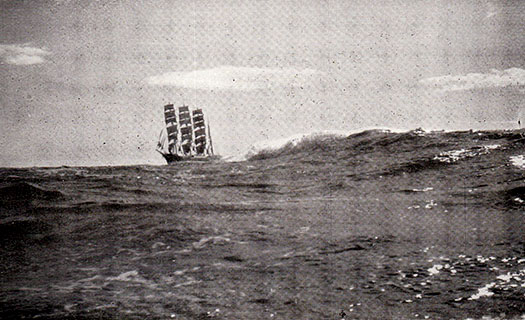
.....yet for many old salts, the true image is the lone ship at sea, going about her business. This photo of a four-masted barque was taken from a small cruising boat in the 1930s
But an ideas-laden shooting of the breeze with O'Hagan soon shows that we're going to have to learn to think a long way out of the box before we begin to meet the demanding expectations of this man and his board of trustees and directors, and the much-anticipated presence of the Tall Ships in Belfast is only a trigger to help activate a much more complex vision. Neil O'Hagan hopes not only to be instrumental in the creation of a new Irish sailing ship, but he also hopes to change the way in which we perceive such a vessel, and our expectations of the way she will be used.
In our initial blog on this back on January 17th, we thought we were making a tellingly adverse point in suggesting that the barquentine Spirit of New Zealand - which the AYT reckons will provide the best model for the development of their project – is not so much a sail training tall ship as we know it, but rather, with her large complement of 40 "trainees", she's more of a floating schoolship which happens to set sails.
Far from being blown out of the water by this "damning" criticism which I and others had voiced, O'Hagan was delighted that we'd lit upon this aspect of the plan. "Old-fashioned sail training has had its day" he says. "When education authorities and social service bodies and welfare funds and philanthropic organisations are looking for some way to provide interesting, satisfying and ultimately long-term-beneficial experiences for young people of all backgrounds and varying states of mental health including the very happily normal, they expect a much broader curriculum than is provided by the traditional sail training model".
"And come to that, so do the young people themselves. If sailing is genuinely their great leisure interest, they'll be into it already at a personal level among like-minded friends. But if they're more typical young people of today, they'll have a wide range of interests, and during the ten day cruises which we hope to make the backbone of the new ship's programme, the sailing will only be part of it."
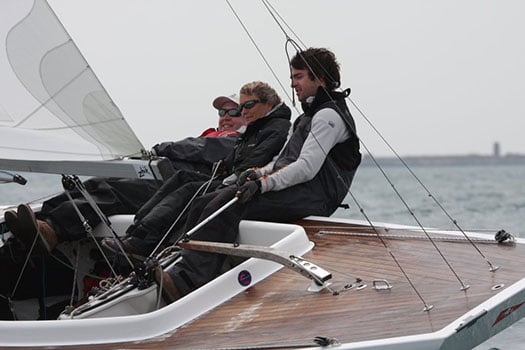
Away from the day job - Neil O'Hagan helming a Dragon
Its not that O'Hagan is anti-sailing. Far from it – he has been seen in the thick of things in the midst of the International Dragon Class in recent years. But a good liberal education with time in the Smurfit Business School in UCD and extensive family links all along Ireland's eastern seaboard north and south, plus direct business experience in both Dublin and Belfast, give him a breadth of vision to provide the AYT with a real sense of purpose.
The Atlantic Youth Trust has been quietly building itself since it emerged from a representative workshop researching the building of a sailing ship for Ireland, held in Dublin Port in the Spring of 2011. From that, a Steering Group of Lord Glentoran and Dr Gerald O'Hare from the north, and Enda O'Coineen and David Beattie from the south – all of whom had worked together before on other north-south youth sailing projects – was set up, and they commissioned a professional consultancy group – CHL Consulting of Dun Laoghaire – to work with them in producing a Vision & Business Plan, which eventually ran to 96 detailed pages.
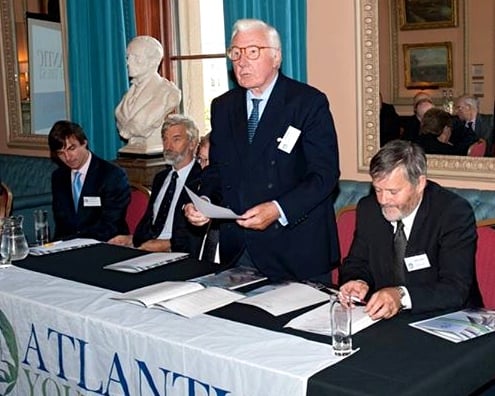
The Chairman Lord Glentoran (Gold Medallist at the 1965 Winter Olympics) at the AGM of the Atlantic Youth Trust with Executive Director Neil O'Hagan (left), Sean Lemass and Director Enda O'Coineen (right)
In due course, the Atlantic Youth Trust emerged with Olympic Gold Medal veteran Lord Glentoran as Chairman. And with Neil O'Hagan as Executive Director, the show was on the road with the detailed worldwide investigation of 25 successful educational schemes involving sailing ships - note we've dropped that "sail training" tag already. And in New Zealand they found something that was really new, something that fell in with their view that the double loss of the Asgard II and the Lord Rank provided an opportunity for a truly fresh look what a national sailing ship might be and do.
It's an extraordinary place, New Zealand - particularly from a maritime point of view. Far from seeing their isolation as a drawback, they use it as an advantage for fresh thinking. And they don't cling to time-hallowed ways brought over from "the old country". On the contrary, being in a new country is seen almost as an imperative for trying new ways and ideas, hence they're at the sharp end of top events like the America's Cup.
And as they were far from the fleets of established tall ships in Europe and America, with the Spirit of New Zealand they had to develop new ways of using a vessel which would spend much of her time cruising their own extensive and very varied coastline on her own, distant from the Tall Ship sailfests which are such a feature of the programme in the more compact and crowded parts of the world.

Spirit of New Zealand is barquentine-rigged
Thus by geographic necessity. New Zealand is ahead of the curve in developing ways of contemporary validity in the use of large sailing ships. We all hear of what a marvellous party the Tall Ships will activate in Belfast, just as they've done before in Dublin, Cork and Waterford. But hold hard just a moment. Isn't sail training aimed at young people mostly between the ages of 15 and 25? Surely their central involvement in vast open air quayside parties - with the inevitable underage alcohol intake possibilities – is totally at variance with the healthy idealism of the concept?
For sure, the organisers of modern Tall Ships Festivals go to enormous effort to ensure that they're genuinely family-friendly events. But the ancient traditions of sailors in port can be difficult to escape. So when you've a proposed programme which is essentially based on recruitment through continuing contact with secondary schools and similar age cohorts – as is the case with the Atlantic Youth Trust project – then it becomes increasingly desirable to have a ship which is large enough to be self-sufficient, with a viable way of onboard life built around large shared areas, such that the traditional waterfront-oriented harbour visits will no longer be such an important part of the cruise programme.

Splendid isolation. Spirit of New Zealand in an anchorage remote even by New Zealand standards
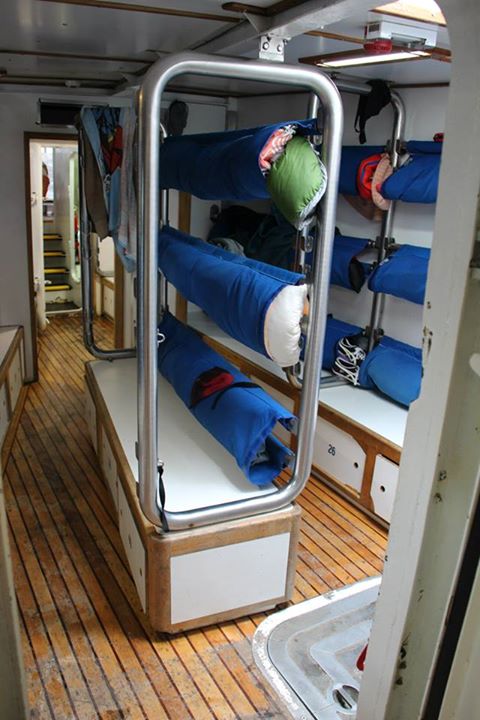
Packing them in....as she carries a crew of 40 trainees, and with space required for extensive communal areas, Spirit of New Zealand's bunks are efficiently planned
Of course the new vessel will take part in Tall Ships Races and Tall Ships Festivals, and of course she'll make the occasional ambassadorial visit, both along the Irish coast and abroad. But with the underlying philosophy of the ship being largely self-sufficient of shoreside distractions other than when they're environmentalist and educational ventures, sometimes with an expeditionary element, then the more gregarious aspects of her yearly routine will be kept well in perspective, and everyone will be the better for it.
As it's essentially a cross-border venture, equal funding from the two governments – each of which it is hoped will put up 30% of the capital expenditure - is anticipated, and with a fresh tranche of Peace Process money on the horizon, the resources are gradually building as people get used to the idea. There has also been much technical background research, and leading naval architects Dykstra of The Netherlands are on the case with an impressive scenario, for as Trustee and Director David Beattie has put it, this one isn't going to be cobbled together, it's going to be a "best in class project".
As the planned use of the vessel is essentially civilian, she will be Ireland's sailing ship without being the national sailing ship. There's more than a slight difference to the Asgard situation. In many other countries, the most impressive tall ships are part of the naval service, but in Ireland we have a Naval Service sailing vessel already, she is the ketch Creidne which was the national sail training vessel between the decommissioning of the first Asgard in 1974 and the commissioning of Asgard II in 1981. In recent years, she has had a major refit and is now actively sailed, but as Ireland's Naval Service is so essentially Cork-based, the Creidne is very much part of the scene in Cork Harbour and the Naval Base at Haulbowline.
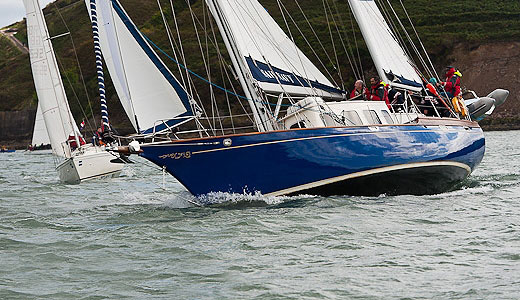
The Naval Service have Creidne for sail training purposes for their own personnel. Photo: Bob Bateman
In fact, although the Atlantic Youth Trust does have a Cork element to it, and advisers include several leading figures in the Cork marine industry, the reality is that it is first and foremost a cross-border enterprise between offices in Dublin and Belfast.
This means that Cork – which is the true capital of maritime development in Ireland, and I mean that in all seriousness – is an associate port to the Atlantic Youth Trust project, rather than a central pillar of it. But I don't think the people of Cork would wish to have it any other way. When I was in the southern capital for the fund-raiser for the new National 18 class development a month or so ago, Class President Dom Long kicked off proceedings by explaining how it was the Corkonian sense of independence which had inspired the mighty leap in National 18 design. He did this by showing a map which neatly illustrated the Cork sailor's view of Ireland.

The Cork sailor's view of Ireland
It says everything. But I don't think the Atlantic Youth Trust should lose any sleep over the fact that they might be seen as being on a Dublin-Belfast axis from which Cork is as usual going its own sweet way. 'Twas ever thus. And anyway, in the end the Corkmen will probably provide many of the officers for the proposed new vessel to which we wish, on this fine Easter Saturday morning, the very fairest of fair winds.
#tallship – With St Patrick's Day almost upon us, the westward trek across the Atlantic in search of American benevolence and funding for worthy objectives can become a very crowded pilgrimage. Among those looking for meaningful support for their pet projects, there will likely be proponents of some sort of new Tall Ship to replace the much-mourned brigantine Asgard II, and the ketch Lord Rank, both of which foundered in 2008 to leave Ireland - north and south alike - bereft of national sail training vessels.
Since then, there have been re-groupings of those who support the admirable concept of sail training for young people. In all, there may be as many as five different bodies on the island of Ireland which now provide access to the international programme. Coiste an Asgard itself was wound up in 2011, but it was immediately re-born as the Dublin-headquartered Sail Training Ireland, the national authority which carries the imprimatur of Sail Training International, the global body which co-ordinates and regulates all sail training.
The other main organisation, often functioning in tandem with Sail Training Ireland, is the Atlantic Youth Trust. It has offices in both Dun Laoghaire and Belfast, and has as its primary objective the construction and commissioning – for all Ireland – of a Class A 40-metre three-masted barquentine. WM Nixon continues with the story.
When we carried a history and analysis of Ireland's involvement with the International Tall Ship and Sail Training movement on this site on January 17th, the immediate response was formidable, and in favour. It continues to register hits at a rate which shows that the maritime community in Ireland has a real wish to see our own proper tall ship.
To achieve this ambition, in terms of having a clearly outlined plan the Atlantic Youth Trust is way ahead. With leading personnel from many parts of Ireland on its high-powered board of Trustees and Directors, the concept - originally inspired by Enda O'Coineen and John Killeen of Galway – is already becoming very complete.
Executive Director Neil O'Hagan and other have researched globally in order to analyse the success of more than two dozen national sail training schemes, and they have concluded that the best model to learn from is the Spirit of Adventure Trust in New Zealand, which functions through training based around the barquentine Spirit of New Zealand, which at 45.2 metres in "sparred length" is steel built registering at 184 gross tons, and carries 40 trainees.
The funding concept on the capital outlay for building the new ship for Ireland will ultimately rely on a total of €15 million being put up jointly by the two governments in the interests of inter-community and cross-border co-operation. Although the current turmoil in the Northern Ireland political administration might temporarily impair the onward progress of the plan, it seems to have a certain inevitable momentum, and highly-regarded Netherlands-based Dykstra Naval Architects have been retained on the project, as have their associates at Damen Shipyards, who may supply the vessel in flatpack form for final construction in Ireland.
As to running costs, the AYT point out that it will come out of current spending, as the vessel by nature of its work will be able to tap into government funds for social welfare and other youth schemes.
Faced with such a juggernaut of ideas, energy, contacts at top government level, and sheer enthusiasm, it seems churlish to question the validity of what is, after all is said and done, a magnificent project. But there are many in Irish sailing in general and sail training in particular who are concerned about the thinking on which it is all based.
To begin with, while we all admire the maritime spirit of New Zealand, does it make sense to draw conclusions for Ireland from a successful scheme in what is essentially a very isolated island nation? Ireland may be an island nation, but it's clearly wide of the mark to describe us as isolated, and this is reflected in the pattern of tall ships visit. If just six tall ships turn up at one port in New Zealand, it's regarded as a major event. But if less than sixty tall ships turn up at this year's Tall Ships Festival in Belfast at the beginning of July, then it will be regarded as a non-event.
In other words, Spirit of New Zealand usually functions in relative isolation, so it is not sail training as we know it in Europe. In fact, she is more of a floating school cum boot camp which happens to set sails, and in order to keep her very numerous trainee complement of 40 busy, while cruising in New Zealand waters (which she does nearly all the time), she is escorted by a large rib which frequently conveys the trainees ashore for land-bound ventures which sometimes out-balance their sea time.
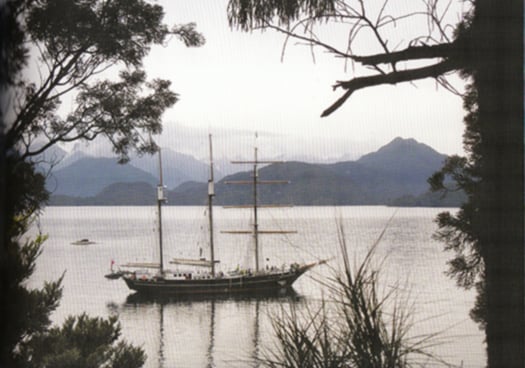
Alone, all alone.....the Spirit of New Zealand in a remote inlet on New Zealand's South Island. With forty trainees and a relatively easily-handled rig, she has a programme whch includes much shoreside activity. Photo courtesy STI
It's a very attractive programme in the New Zealand context, as they have many remote coastal areas which are virtually uninhabited and ripe for shore adventures which will not conflict with the rights of local inhabitants. But in Ireland and much of Europe such a programme would immediately meet problems, and for Ireland it makes more sense to follow the European pattern which puts an almost total emphasis on voyaging and sail training races.
Were a heavily-crewed vessel such as Spirit of New Zealand to do the European programme, there simply wouldn't be enough work for the 20 trainees on each watch to keep them happily occupied for long periods. Ideally, trainee tall ships are extremely labour-intensive for all hands, and in Europe that's the way it is done, but it needs what amounts to individual attention for each trainee.
So it's difficult to escape the conclusion that one reason for the attraction of the New Zealand scheme for the Atlantic Youth Trust is that it wins out in the numbers game. Forty young people taken out of troubled and aimless environments ashore, and sent away together on a voyage, is an impressive amount of social problems temporarily sorted in one fell swoop.
But will it be as behaviourally beneficial, in the long term, as it would be for a smaller number of people on a smaller and busier vessel? It will vary from case to case, but generally you'd reckon that the smaller more personal crew setup, with each trainee more directly involved in the sailing of the ship, would produce better results, while always remember that having as much square rig as possible is central to the concept.
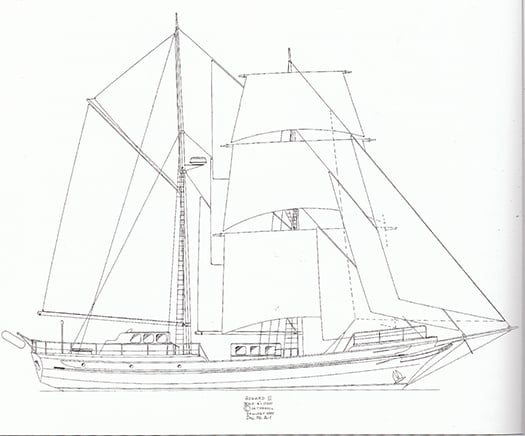
A timeless design which remains a very viable proposition for an easily managed ship which keeps her crew busy. Jack Tyrell's lines for Asgard II would lend themselves to construction in steel or even aluminium.
Ideally, to see Ireland's Tall Ship-owning reputation restored, many of us would like to see not just one newly-built replica of the 84ft brigantine Asgard II being launched, but three – one each for Cork, Dublin and Belfast. For, at the moment, the main axis of Atlantic Youth Trust activity seems to be between Dublin and Belfast. Yet as last weekend's National Annual Sailing Awards ceremony in Dublin so clearly underlined, Cork is really where it's at in terms of maritime development, and the lack of a significant Cork element seems to be a weakness of the AYT scheme.
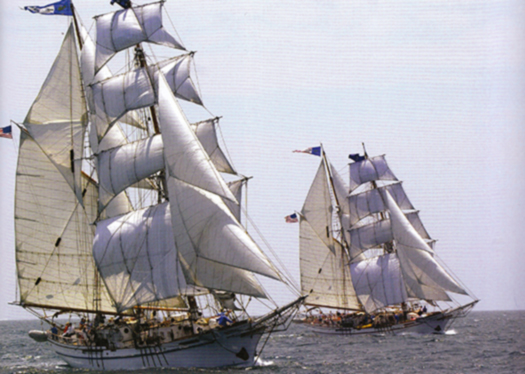
Might this be the way forward? One of our suggestions today is that Ireland really needs three Asgard IIs, based in Cork, Dublin and Belfast. We get an idea of how it might look with the two sister-ship American brigantines Exy Johnson and Irving Johnson, which are based in Los Angeles in California, where they were built in 2002.
Nevertheless, it says much for the dedication and energy of those promoting the Atlantic Youth Trust that we have the luxury of debating the validity of their plans, which have been so thoroughly developed. We may disagree with their conclusion, but it's not total disagreement – an Irish version of Spirit of New Zealand would be a very emphatic improvement on our present ship-less state, which is too much of a reflection of an ancient and negative mind-set.
Every time you see the Tall Ships gather and see how maritime countries of population comparable to Ireland, such as Norway, Denmark and Portugal, can send forth spectacularly handsome Tall Ships, it becomes a painful reminder of how the new Irish Free State increasingly turned its back on the sea.
The fact was admitted by Minister for the Marine Simon Coveney at last week's National Sailing Awards Ceremony in a speech which hinted at some very significant developments in the Irish maritime sphere in the near future.
But really, what Minister Coveney was talking about is that it is time and more for us to grow up in our attitude to the sea. When the Free State was struggling into being in 1922, the popular view was that British power was synonymous with sea power. So if you were against the sea and seafaring in all its manifestations, then you were demonstrating the purity of your patriotism through adopting what was essentially if subconsciously an anti-British stance. Childish perhaps. But we all know that's the way it was.
So despite the flurry of maritime enthusiasm which was engendered by national emergency during World War II to inspire the creation of Irish Shipping and the Maritime Inscription, what this meant was that when the underlying attitude genuinely began to change in the 1950s, a positive attitude towards the sea wasn't being built upwards from Ground Zero. It was being built from Ground Minus Thirty – the number of years that an anti-maritime attitude had been the unstated yet very real official policy.
Thus there was a period when Irish maritime enthusiasm had to be kept going almost as a secret cult, and I'd an odd reminder of this some weeks back at the annual Awards Ceremony of Sail Training Ireland. The Patron of STI is President Higgins, and the event was held – for the second year running – in the Mansion House in Dublin. Yet the very fact of the identity of their Patron, and of their event being staged in the Mansion House in the presence of Lord Mayor Christy Burke, provided such pleasure and pride for everyone in the gathering that it was a forceful reminder that, not so very long ago, seafaring was very much the poor relation in Ireland, and there were those in authority who would have happily air-brushed it out of the national picture entirely, leaving it to foreign crews to undertake the rough trades of the sea.
But thanks to those former members of Coiste an Asgard who refused to give up the vision of sail training for Ireland, even as the onset of economic Armageddon from 2008 to 2011 made any prospect of a new Asgard II a very distant vision as the government chucked the €3.8 million insurance payout into the bottomless pit of national debut, Sail Training Ireland arose like a Phoenix and set in place sail training bursaries for places on foreign tall ships, using international contacts built up during the 27 successful Asgard II years to ensure that Ireland could re-build our position at the heart of the movement.
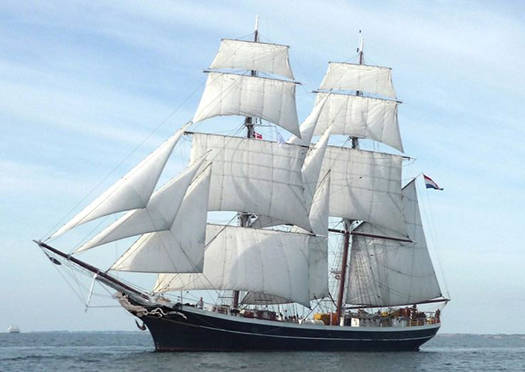
She keeps them busy....the Dutch brig Morgenster is superbly labour-intensive in the best sail training traditions. Photo courtesy STI
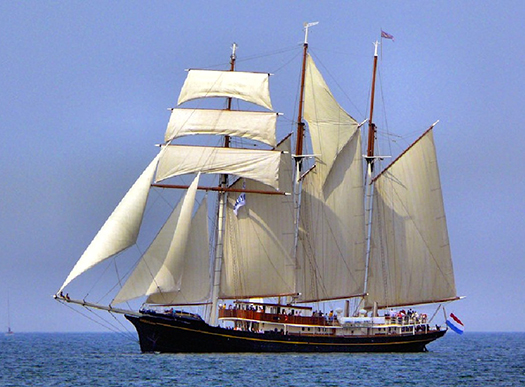
Gulden Leeuw is another of the Dutch Tall Ships which have been taking Irish trainees to sea on Sail Training International programmes. Photo: Courtesy STI
The thriving tall ships scene in the Netherlands – which has become a focal point for sail training and the Tall Ships industry for all Europe – proved the most fruitful placement area, with most Irish trainees being positioned aboard the very handsome 48 m (sparred length) brig Morgenster, which has become a familiar sight in Irish ports. Another ship well used is the three-masted topsail schooner Gulden Leeuw, a long slim craft as she is 70 m in sparred length, while that noted poster girl of Tall Ships sailing, the 56 metre three masted Dutch barque Europa, also carried Irish crew from time to time.
However, while placements on such vessels work very well, the hankering for an Irish sail training flagship is always there, and fortunately in recent years Oliver Hart's 70ft training schooner Spirit of Oysterhaven has been punching way above her weight in filling the role in gallant style with a varied programme on the Irish coast.
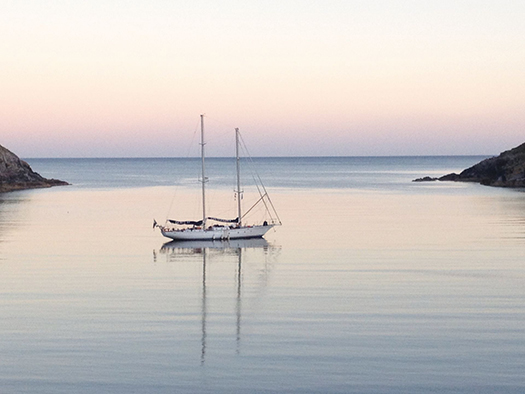
Spirit of Oysterhaven in South Harbour, Cape Clear Photo: Oliver Hart
This and much more was reflected in the Sail Training Ireland Awards Ceremony in the Mansion House, a goodly gathering which was representative not just of every possible aspect of sail training at home and abroad, but also of Irish ports which are increasingly interested in an activity which brings their ancient waterfronts vividly to life. And the progress of various ship projects was spoken for by everything from complete vessels such as the Basque Spanish schooner Atyla represented by Rodrigo de la Serna, through vessels in the making as personified by our own ketch Ilen. She has since seen her final new plank knocked ceremonially into place at Oldcourt in Baltimore, but here's an evocative video Gary MacMahon left with us of the creative planking process under way. And present too was Neil O'Hagan of Atlantic Youth Trust, whose organisation deservedly received recognition for their pioneering work towards a completely new ship.
{youtube}ZLT3D8TBbwk{/youtube}
The main awards presented in the Mansion House by STI Chairman Seamus McLoughlin, who is former Head of Operations for Dublin Port, were:
1. Trainee of the year: Andrew Crowley
2. Special Contribution Award: Turlough Kennedy
3. Special Achievement Award: Fiona Armson
4. Perpetual Asgard Award: For an outstanding contribution to, or achievement in Sail Training by an individual or group: Atlantic Youth Trust / Foroige Group of Trainees
5. Watch-leader of the Year: Sara Mason
6. Volunteer of the year: Jonathan O'Brien
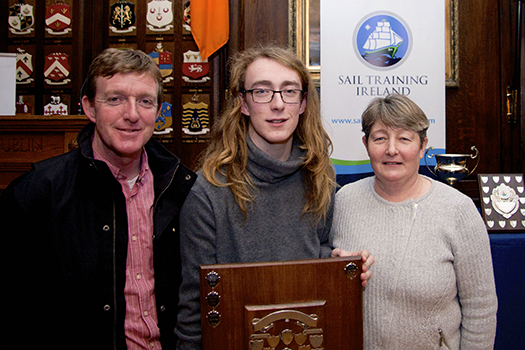
Trainee of the Year Andrew Crowley with his parents in the Mansion House
Trainee of the Year Award: Andrew Crowley
Andrew is Club Captain of the Spirit of Oysterhaven Trust. During 2014, he was instrumental in helping to organise the Club's sailing trips aboard Spirit of Oysterhaven with a special emphasis on providing opportunities for young people with disability. He helped to organise the Club's Youth in Action programme, and crewed aboard Spirit during the Irish Cruising Club's sponsored Anniversary voyage from Glandore to Glengariff with a crew of eight trainees, including several with disability. During the summer Andrew was a vital member of a short-handed crew delivering Spirit from Oysterhaven to Glandore during which he proved himself an outstanding active crew member.
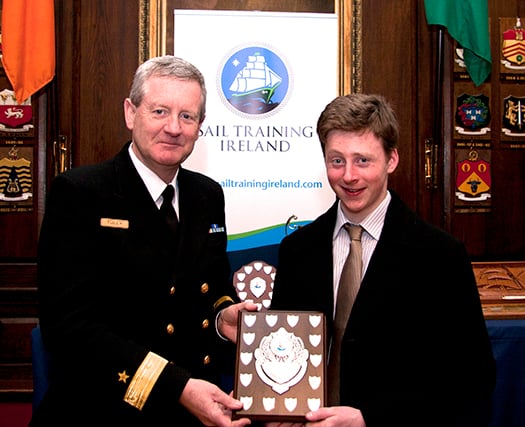
Commodore Hugh Tully, Flag Officer Commanding Naval Service, with Turlough Kennedy, who received the Special Contribution Award
Special Contribution Award: Turlough Kennedy
This year's special contribution award goes to Turlough Kennedy from the lakeside port of Scarriff in County Clare for the outstanding role he filled on the Dutch tall ship Morgenster.
To quote Michael Byrne, Director of Sail Training Ireland: "This contribution was not only recognised by us. On completion of last year's voyage Turlough - despite his limited sea going experience - was offered a crew member's berth on board the ship by the Captain. While he was not in a position last year to take up this offer for the remainder of the 2014 season, in 2015 we are delighted that Turlough will be sailing as voluntary crew on board the Morgenster. The following is a short note from the ship's Captain, Harry Muter: "Turlough sailed with us last year and he was very good good both in the sailing department as in the social processes. For his age he was surprisingly adult, patient and emphatic. And then the music, it coloured this voyage, and Turlough played a role with his complicated bagpipe and improvisation talent. Looking forward to sail with him again." " (There are no prizes for guessing that "complicated bagpipes" are Uileann Pipes).
Special Achievement Award: Fiona Armson
The special achievement award this year went to Fiona Armson for the tenacity and determination she showed by completing her 14 day voyage. Fiona found some aspects of life at sea a real challenge but despite being given several opportunities by her leaders and the crew to take on a lighter work load Fiona refused to leave her watch and pushed on.
Fiona completed her voyage having never missed a single watch or duty and, in a way that would put a smile on any sailor's face, she sailed the Gulden Leeuw into her home port of Bangor.
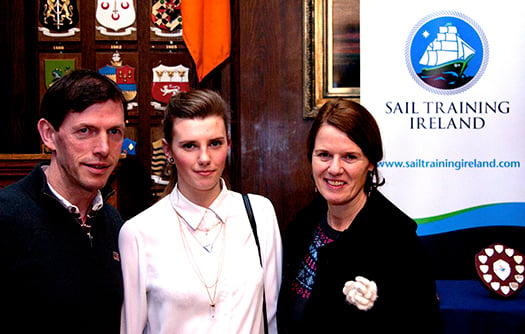
Special Achievement Award Winner Fiona Armson with her parents
Perpetual Asgard Award
Awarded to a group of four Foroige Trainees: Michael Collins, Dean Mc Keon, Brandon McDonagh, and Daniel O'Halloran,
In March 2014, four young people from Ballybane in Galway set out on a remarkable adventure, travelling half way around the world to experience the Spirit of Adventure's 10-Day Youth Development Voyage in New Zealand. Three youth workers accompanied the group for the three week trip, and one of them, Pearse O'Toole, was at the Mansion House with them. The trip was funded by a private donation and managed by the Atlantic Youth Trust and Foroige.
The group spent 10-days sailing around the magnificent Hauraki Gulf off Auckland on the barquentine Spirit of New Zealand. They adapted very well to their new surroundings as crew members and returned with fresh skills, more confidence than ever, and a new outlook on life and what is possible.
Neil O'Hagan, Executive Director of the Atlantic Youth Trust, followed this award with a presentation about the Peace and Reconciliation Fund-supported Sea-Connections scheme, and then the next award was remarkably appropriate, as it was for the Watch Leader of the Year and it went to Sara Mason for her very successful participation in an EU Youth Exchange Voyage on Gulden Leeuw.
Sara (pronounced saarah) is from the North Island of New Zealand, but now lives and studies in Dublin. She is part of the Shackleton Outdoor Adventure Management Diploma Course in Colaiste Dhulaigh in Coolock. She joined the team of youth leaders which facilitated the main voyage programme of Youth Exchange projects in May-June. As a leader on the Dutch Ship Gulden Leeuw, she cared for and facilitated a group of 40 young adults over a 14 day period. She was an outstanding support to them as a leader, and brought with her a set of skills that are unique to professionals who spend their lives working with people in the outdoor adventure industry. She also has a fantastic energy and enthusiasm and was an inspiration to the trainees and other leaders.
Volunteer of the Year Award - Jonathan O'Brien
Jonathan has become involved in a multitude of voluntary activities with Sail Training Ireland in the last year. In 2013 he volunteered as a youth leader for one of STI's youth exchange voyages for 10 days from Belfast to Dublin. In 2014 he was head-leader across youth exchange voyages with a total of 8 leaders, with at times up to 100 trainees across three ships seeking his support.
Having a background in both outdoor education and in social care, Jonathan has an exceptional set of skills that lend themselves very well to the role of leader on a tall ship, and he has now found himself "volunteered" for a position on STI's sub-committee for trainee programmes. During 2014, he also spent time on a number of ships across Europe, while somehow also fitting in a spell serving as First Mate on the Spirit of Oysterhaven. He is helping to develop on-board programmes for a number of STI's funded voyage schemes during 2015, and will also train STI's group of twelve youth leaders in April.
So the good work goes on, but the more of it there is, the more it become apparent that Ireland needs her own tall ship, and the sooner the better. A programme of international placement may work very well for those in the know, but for people down the country which are remote from maritime communities, it often takes the stimulus and sense of pride engendered by an Irish ship to make that first move afloat.
It was summed up so well by investigative academic and journalist Dr Elaine Byrne in our story about the Tall Ships on January 17th that it deserves repeating here. Usually in her line of work, Elaine Byrne takes no prisoners. But the quiet depth of feeling underlying the brief story of how the Byrne family from the deepest rural depths of County Carlow became involved in sail training has a resonance for us all today:
"I'm the oldest of seven children from a farming family on the Carlow/Wicklow border, where the household income is augmented with a funeral undertaking business attached to a pub in which I might still work on visits home. Our background is just about as far as it's possible to be from Ireland's maritime community. Yet thanks to Asgard II, I was able to take a step into the unknown world of the high seas as a trainee on board, and liked it so much that over the years I spent two months in all on board, graduating through the Watch Leader scheme and sailing in the Tall Ships programmes of races and cruises-in-company.
Down in the depths of the country, my new experiences changed the family's perceptions of seafaring. Four of my siblings then had the opportunity to sail on Asgard II. If it were not for Asgard II, my family would never have had the chance to sail, as we did not live near the sea, nor had the financial resources to do so. The Asgard II played a large role in our family life as it became a Rite of Passage to sail on board her. My two youngest siblings did not sail on Asgard II because she sank, which they much regret.
Apart from the discipline of sailing and the adventure of new experiences and countries, the Asgard II brought people of different social class and background together. There are few experiences which can achieve so much during the formative years of young adulthood".
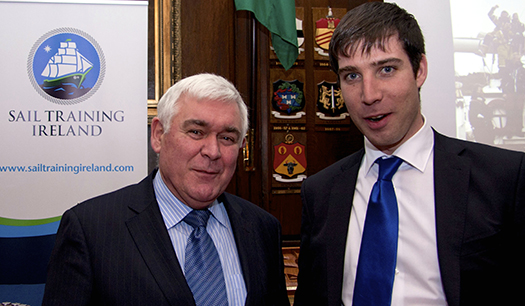
Seamus McLoughlin, Chairman of Sail Training Ireland, with Michael Byrne, Director.

Carolanna Foley, awarded a Drogheda Port Sail Training Bursary, with Seamus McLoughlin (left) and Commodore Hugh Tully
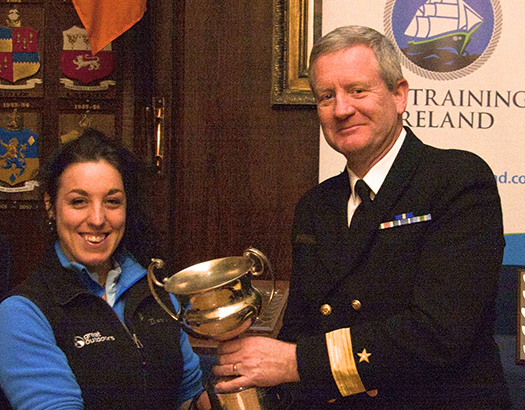
Sara Mason, Watch Leader of the Year, with Commodore Hugh Tully

Jonathan O'Brien (left) Volunteer of the Year, with Oliver Hart
- Sagres
- Tall ship
- Coiste an Asgard
- Atlantic Youth Trust
- barquentine
- Sail Training Ireland
- Sail Training International
- John Killeen
- Enda O'Coineen
- Neil O'Hagan
- Dykstra
- Damen Shipyard
- sailing
- Simon Coveney
- Lord Mayor
- Phoenix
- Spirit of Oysterhaven
- Europa
- Morgenster
- Gulden Leeuw
- Basque Spanish schooner Atyla
- Ilen
- Elaine Byrne
- Oysterhaven
- Mansion House
- Christy Burke
- World War II
A New Tall Ship For Ireland? It's Back to The Future
#tallship – The Tall Ships return to Ireland in spectacular style this summer with a major fleet assembly in Belfast from Thursday 2nd to Sunday 5th July for the beginning of the season's Tall Ships Races, organised by Sail Training International. The seagoing programme will have a strong Scandinavian emphasis in 2015, with the route - some of which is racing, other sections at your own speed – starting from Belfast to go on Aalesund in western Norway for 16th to 18th July, thence to Kristiansand (25th to 28th July), which is immediately east of Norway's south point, and then on to conclude at Aalborg in northern Denmark from 1st to 4th August.
But before leaving Northern Ireland with the potentially very spectacular Parade of Sail down Belfast Lough on Sunday July 5th, the celebrations will be mighty. The fleet's visit will be the central part of the Lidl Belfast Titanic Maritime Festival, which will include everything from popular family fun happenings with concerts and fireworks displays – the full works, in other words – right up to high–powered corporate entertainment attractions.
As for the ships, there will be more than enough for any traditional rig and tall ship enthusiast to spend a week drooling over. In all, as many as eighty vessels of all sizes are expected. But more importantly, at least twenty of them will be serious Tall Ships, proper Class A square riggers of at least 40 metres in length, which is double the number which took part in their last visit to Belfast, back in 2009.
That smaller fleet of six years ago seemed decidedly spectacular to most of us at the time. So the vision of a doubling of proper Tall Ship numbers in Belfast Harbour is something we can only begin to imagine. But when you've a fleet which will include Class A ships of the calibre of the new Alexander von Humboldt from Germany, Norway's two beauties Christian Radich and Sorlandet, the much-loved Europa from the Netherlands, George Stage from Denmark, and the extraordinary Shtandart from Russia which is a re-creation of an 18th Century vessel built for Emperor Peter the Great, you're only starting, as that's to name only six vessels – what we'll be seeing will be a truly rare gathering of the crème de la creme.
So although it would be stretching it to think that a small country like Ireland should aspire to having a major full-rigged vessel, we mustn't forget that for 27 glorious years we did have our own much-admired miniature Tall Ship, the gallant 84–ft brigantine Asgard II. Six-and-a-half years years after her loss, it's time and more for her to be replaced. W M Nixon takes a look at what's been going on behind the scenes in the world of sail training in Ireland and finds that, in the end, we may find ourselves with a ship which will look very like a concept first aired for Irish sail training way back in 1954.
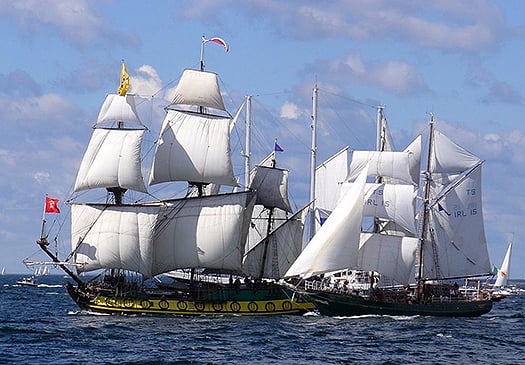
The pain of it. You search out a photo of Shtandart, the remarkable Russian re-creation of an 18th century ship, and you find that Asgard II is sailing beside her
It was while sourcing a photo of Russia's unusual sail training ship Shtandart that the pain of the loss of Asgard II emerged again. It's always there, just below the surface. But it's usually kept in place by the thought that we have to move on, that worse things happened during the grim years of Ireland plunging ever deeper into recession, and that while our beloved ship did indeed sink, no lives were loss and her abandonment was carried out in an exercise of exemplary seamanship.
Yet up came the photo of the Shtandard, and there right beside her was Asgard II, sailing merrily along on what's probably the Baltic, and flying the flag for Ireland with her usual grace and charm. The pain of seeing her doing what she did best really was intense. She is much mourned by everyone who knew her, and particularly those who crewed aboard her. All three of my sons sailed on her as trainees, they all had themselves a great time, and two of them enjoyed it so much they repeated the experience and both became Watch Leaders. It was very gratifying to find afterwards, when you went out into the big wide world and put "Watch Leader Asgard II" on your CV, that it counted for something significant in international seafaring terms.
But as a sailing family with other boat options to fall back on, we didn't feel Asgard II's loss nearly as acutely as those country folk for whom the ship provided the only access to the exciting new world of life on the high seas.

Elaine Byrne vividly recalls how much she appreciated sailing on Asgard II, and how she and her siblings, growing up in the depths of rural Ireland, came to regard the experience of sailing as a trainee on the ship as a "Rite of Passage" through young adulthood
The noted international investigative researcher, academic and journalist Dr Elaine Byrne is from the Carlow/Wicklow border, the oldest of seven children in a farming family where the household income is augmented with a funeral undertaking business attached to a pub in which she still occasionally works. Thus her background is just about as far as it's possible to be from Ireland's limited maritime community. Yet thanks to Asgard II, she was able to take a step into the unknown world of the high seas as a trainee on board, and liked it so much that over the years she spent two months in all aboard Asgard II, graduating through the Watch Leader scheme and sailing in the Tall Ships programmes of races and cruises-in-company
Down in the depths of the country, her new experiences changed the Byrne family's perceptions of seafaring. Elaine Byrne writes:
"Four of my siblings (then) had the opportunity to sail on Asgard II. If it were not for Asgard II, my family would never have had the chance to sail, as we did not live near the sea, nor had the financial resources to do so. The Asgard II played a large role in our family life as it became a Rite of Passage to sail on board her. My two youngest siblings did not sail on the Asgard II because she sank, which they much regret".
She continues: "Apart from the discipline of sailing and the adventure of new experiences and countries, the Asgard brought people of different social class and background together. There are few experiences which can achieve so much during the formative years of young adulthood"
That's it from the heart – and from the heart of the country too, from l'Irlande profonde. So, as the economy starts to pick up again, when you've heard the real meaning of Asgard II expressed so directly then it's time to expect some proper tall ship action for Ireland in the near future. But it's not going to be a simple business. So maybe we should take quick canter through the convoluted story of how Asgard II came into being, in the realization that in its way, creating her successor is proving to be every bit as complex.
As we shall see, the story actually goes back earlier, but we'll begin in 1961 when Erskine Childers's historic 1905-built 51ft ketch Asgard was bought and brought back by the Irish government under some effective public pressure. It was assumed that a vessel of this size – quite a large yacht by the Irish standards of the time – would make an ideal sail training vessel and floating ambassador. It was equally assumed that the Naval Service would be happy to run her. But apart from keen sailing enthusiasts in the Naval Reserve - people like Lt Buddy Thompson and Lt Sean Flood – the Naval Service had enough on its plate with restricted budgets and ageing ships for their primary purpose of fishery patrol.
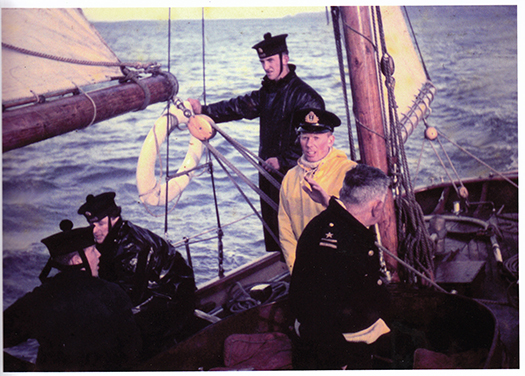
Aboard the first Asgard in 1961 during her brief period in the 1960s as a sail training vessel with the Naval Service – Lt Sean Flood is at the helm
So Asgard was increasingly neglected throughout the 1960s until Charlie Haughey, the new Minister for Finance and the only member of Government with the slightest interest in the sea, was persuaded by the sailing community that Asgard could become a viable sail training ship. In 1968 she was removed from the remit of the Department for Defence into the hands of some rather bewildered officials in the Department for Finance, and a voluntary committee of five experienced sailing people - Coiste an Asgard - was set up to oversee her conversion for sail training use in the boatyard at Malahide, which just happened to be rather less than a million miles from the Minister's constituency.
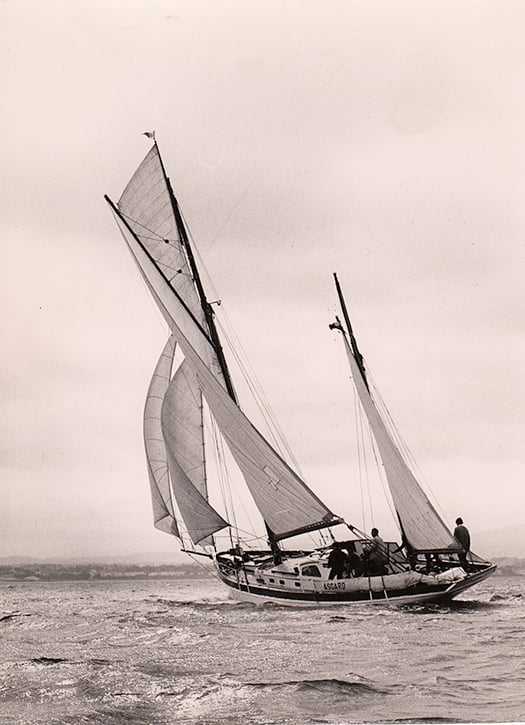
Asgard in her full sail training role in 1970 in Dublin Bay
Asgard was commissioned in her new role in Howth, the scene of her historic gun running in 1914, in the spring of 1969. Under the dedicated command of Captain Eric Healy, the little ship did her very best, but it soon became obvious that her days of active use would be limited by reasons of age, and anyway she was too small to be used for the important sail training vessel roles of providing space to entertain local bigwigs and decision-makers in blazers.
By 1972, the need for a replacement vessel was a matter of growing debate in the sailing community, and during a cruise in West Cork in the summer of 1972, I got talking to Dermot Kennedy of Baltimore out on Cape Clear. Dermot was the man who introduced Glenans to Ireland in 1969, and then he branched out on his own in sail training schools. A man of firm opinions, he reacted with derision to my suggestion that Asgard's replacement should be a modern glassfibre Bermudan ketch, but with enough sails to keep half a dozen trainees busy.
"Nonsense" snorted Dermot. "Ireland needs a real sailing ship, a miniature tall ship maybe, but still a real ship, big enough to carry square rig and have a proper clipper bow and capture the imagination and pride of every Irish person who sets eyes on her. And she should be painted dark green just to show she's the Irish sail training ship, and no doubt about it".
Some time that winter I simply mentioned his suggestions in Afloat magazine, and during the Christmas holidays they were read by Jack Tyrrell at his home in Arklow. During his boyhood, in the school holidays he had sailed with his uncle on the Arklow schooner Lady of Avenel, and it had so shaped his development into the man who was capable of running Ireland's most successful boatyard that he had long dreamed of a modern version of the Lady of Avenel to be Ireland's sail training ship.
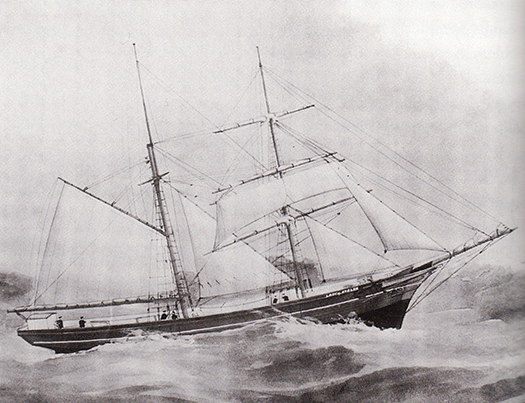
The inspiration – Jack Tyrrell's boyhood experiences aboard Lady of Avenel inspired him to create Ireland's first proper sail training ship
In fact, in 1954 he had sketched out the plans for a 110ft three masted training ship, but Ireland in the 1950s was in the doldrums and the idea got nowhere. Yet the spark was always there, and it was mightily re-kindled by what Dermot Kennedy had said. So at that precise moment, the normal Christmas festivities in the Tyrrell household were over. They'd to continue the celebrations without the head of the family. The great man took himself off down to the little design office in his riverside boatyard, and in clouds of pipe tobacco smoke, he re-drew the lines of the 110ft three master to become an 83ft brigantine, the size reduction meaning that the shop would only need a fulltime crew of five.
Working all hours, he had the proposal drawings finished in time to rejoin his family to see in the New Year. And in the first post after the holiday, we got the drawings at Afloat, and ran them in the February 1973 issue.
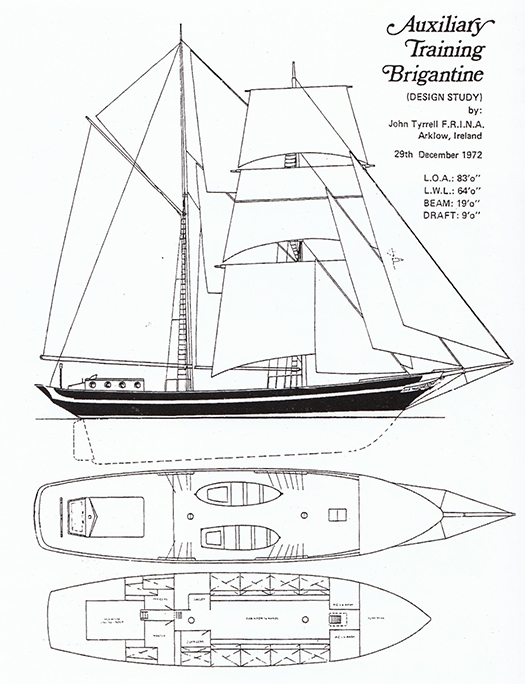
Jack Tyrrell's proposal drawings for the new brigantine, as published in the February 1973 Afloat
In Ireland then as now, most politicians had inscribed in their heads the motto: "There's No Votes In Boats". So after Charlie Haughey had fallen from favour with the Arms Trial of 1970, Coiste an Asgard became an orphan. But 1973 brought a new government, and there was one cabinet minister in it who was proud to proclaim his allegiance to the sea.
Unfortunately for the respectability of the maritime movement in Ireland, our supporters in the higher echelons of politics have often tended to be from the colourful end of the political spectrum, whatever about their placing in the left-right continuum. Thus it was that, at mid-morning on St Patrick's Day 1973, I got an ebullient phone call and an immediate announcement, without the caller saying who he was. "Winkie" he bellowed, "That ship is going to be built. I'll make sure of it. I've just made a ministerial decision".
It emerged that it was our very own new Minister for Defence, Patrick Sarsfield Donegan TD. The enthusiasm for the new ship, engendered by studying Jack Tyrrell's drawings, led to a snap decision which stayed decided, and it all happened in the Department for Defence.
However, it was 1981 by the time the ship was launched, and she looked rather different from Jack Tyrrell's preliminary drawings, though the basic hull shape built in timber was the same sweet lines as originally envisaged, so she was able to sail like a witch. But as for her supporters at Government level, the non-stop cabaret continued. Charlie Haughey had regained power, and by 1981 he was Taoiseach. It was he who had seen to it that the Department of Defence continued to look after the Asgard II project with support from another sailing TD who might not have seen eye–to-eye with him on other matters, Bobby Molloy of Galway.
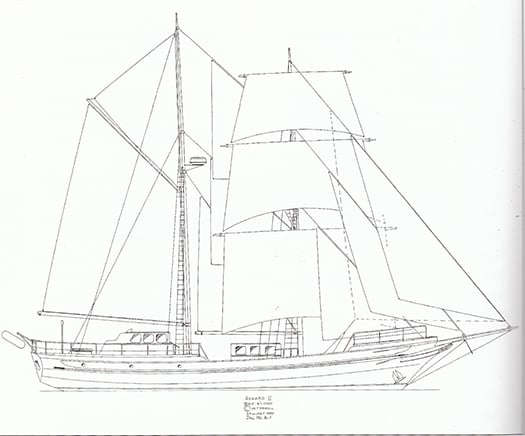
Asgard II in her finished form
So on a March day in 1981, almost exactly twelve years after he'd commissioned the original Asgard in her new role as a sail training vessel, Charlie Haughey took it upon himself to christen the new Asgard II in Arklow basin. And the champagne bottle refused to break. Five or six time he tried, but with no success.
Showing considerable grace under pressure and observed by a large crowd, he quietly took his time undoing all the ribbons and paraphernalia on the big bottle. Then he marched with it up to the new flagship's stem, and hit it a mighty double-handed wallop. The bottle exploded that time, with no mistake. And apart from the usual Haughey growl to those nearby about the idiocy of whoever forgot to score the champagne bottle beforehand, it was all done with the best of humour.
For most of her subsequent career, there's no doubt Asgard was a lucky and very successful vessel. Yet when her demise came, you couldn't help but think of the old notion that if the champagne bottle doesn't break first time, then she'll ultimately be an unlucky ship.
But there are more prosaic explanations. With a limited budget and every penny being scrutinized, Jack Tyrrell and his men had to build Asgard II in fishing boat style, which is fine within its proper time span, but that time span is really only twenty years, maybe thirty if the ship gets extra care. But with her fishing boat hull carrying a demanding brigantine rig, although she always looked immaculate, Asgard II was starting to show her age in the stress areas.
By 2005 there was serious talk about the need to plan for a replacement. When her skipper Colm Newport was told to renew her rig as the original spars were clearly well past it, he meticulously searched the best timber yards at home and abroad and when she got her new rig – it was 2006 or thereabouts – I wrote an only slightly tongue-in-cheek article suggesting that now was the time to replace her old tired wooden hull with a new steel one to the same Jack Tyrrell lines, but utilising the excellent new rig and as many of the fixtures and fittings as were still in good order from the original ship.
To say the response was negative is understating the case. People's attachment to Asgard could only imagine a wooden ship. It was the end of any meaningful debate. So things drifted on, with each new government seemingly even less interested in maritime matters generally, and sail training in particular, than the one before.
In September 2008, Asgard started taking in water while on passage with a crew of trainees towards La Rochelle for a maritime festival following which - while still in La Rochelle – it was planned that she would be lifted out for a thorough three week survey and maintenance programme.

Asgard's accommodation worked superbly whether at sea or in port. But the fact that so much was packed into a relatively small hull meant that some areas were almost inaccessible for proper inspection
It might have been the saving of her. But it was not to be. It's said that it was a failed seacock which caused the catastrophic ingress of water. She was a very crowded little ship, she packed a lot into her 84ft, so some hull fittings were less accessible internally than they would be in a more modern vessel, and may have deteriorated to a dangerous level. But if, as some would propose, she hit something in the water which caused a plank to start, then the fact that nobody aboard was aware of any impact suggests that the time for a major overhaul, and preferably a hull replacement, was long overdue.
The moment Asgard II sank, she ceased to have any future as a sail training vessel, and there was no real official interest in her salvage. You simply cannot take other people's children to sea on a salvaged vessel of doubtful seaworthiness. And as it happens, the sinking came at exactly the time the Irish economy fell of a cliff. So although after an enquiry the Government accepted a €3.8 million insurance settlement, in the end, despite assurances to the contrary, it disappeared into the bottomless pit which was the national debt, and within a year Coiste an Asgard was wound up with its records and few resources incorporated into a new entity, Sail Training Ireland.
The plot takes a further macabre twist in that, shortly after the loss of Asgard II, the Northern Ireland Sailing Training ketch was also lost after hitting a rock on the Antrim coast. From having two popular and well-used sail training vessels in the middle of 2008, within a year Ireland had no official sail training vessels at all.
Yet though the flame had been largely subdued, there were those who have kept the faith, and gradually the sail training movement is being rebuilt. Sail Training Ireland is the frontline representative for around five different organisations, being the official affiliate of Sail Training International, and it has a busy programme of placing trainees in ships which operate at an international level, in which the Dutch are supreme.
In Ireland at the moment, the only sail training "ship" is the schooner Spirit of Oysterhaven, run by Oliver Hart and his team from their adventure centre near Kinsale. In fact, Spirit – you can read about her in Theo Dorgan's evocative book Sailing For Home (Penguin Ireland 2004) – really is punching way above her weight in representing Ireland in a style reminiscent of both the Asgards.
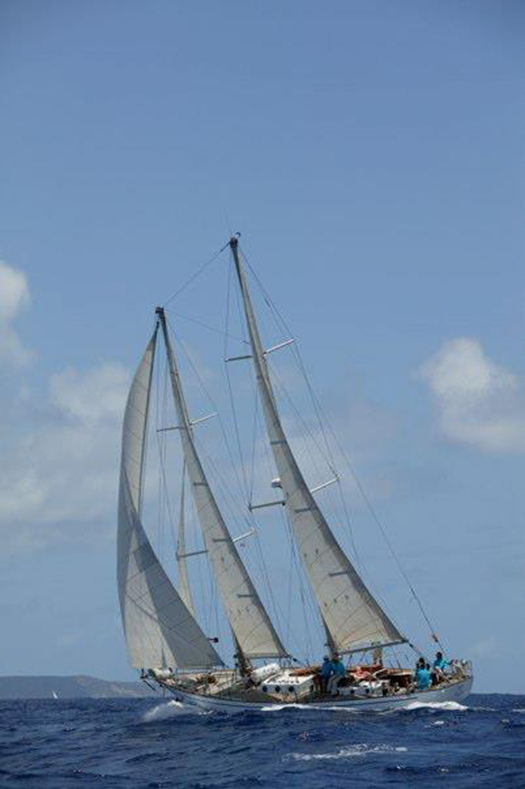
Spirit of Oysterhaven has been doing great work in keeping sail training alive in Ireland
But having the ship is one thing, paying the fees for the trainees to be aboard is something else, and sail training bursaries are one of the key areas of expansion in current maritime development in Ireland. There was an unusual turn to this in 2014 when somebody came up with the bright idea of using Irish Cruising Club funds (which are generated by the surplus from the voluntary production of the club's Sailing Directions) to provide bursaries for youngsters to take part in last summer's ICC 85th Anniversary Cruise-in-Company along the southwestern seaboard on Spirit of Oysterhaven.
The idea worked brilliantly, and this concept of neatly-tailored sail training bursaries is clearly one which can be usefully developed. But still and all, while it's great that young Irish people are being assisted in getting berths aboard charismatic vessels like Europa, the feeling that we should have our own proper sail training ship again is gradually gaining traction, and this is where the Atlantic Youth Trust comes in.
The AYT had its inaugural general meeting in Belfast as recently as the end of September 2014, so it may not yet have come up on your radar. But as it has emerged out of the Pride of Ireland Trust which in turn emerged from the Pride of Galway Trust, you'll have guessed that Enda O'Coineen and John Killeen are much involved, and they've roped in some seriously heavy hitters from both sides of the border, either as Board Members or backers, and sometimes as both.
The cross-border element is central to the concept of building a 40 metre three-masted barquentine, a size which would put her among the glamour girls in Class A, and could carry a decidedly large complement of 40 trainees, even if you're inevitably talking of stratospheric professional crewing costs.
However, by going straight in at top government level on both sides of the border, the AYT team are finding that they're pushing at a door which wants to open, particularly after the new Stormont House agreement was reached in the last days of 2014 to bring a more enthusiastic approach both to cross-community initiatives in the north, and cross border co-operation generally.
Who knows, but if they can succeed in getting cross-community initiatives working in Northern Ireland, then they may even be able to swing some sort of genuine Dublin-Cork shared enthusiasm in the Republic, for I've long thought that one of the factors in holding back many maritime initiatives in Ireland is that, while Dublin may be the political capital, Cork is quietly confident it's the real maritime capital, and does its own thing.
Be that as it may, the AYT have done serious studies, and their conclusion is the best scheme to learn from is the Spirit of Adventure programme in New Zealand. This is where the feeling of going back to the future arises, for in looking at photos of their ship Spirit of New Zealand, there's no escaping the thought that you're looking at Jack Tyrrell's concept ship of 1954 brought superbly to life.
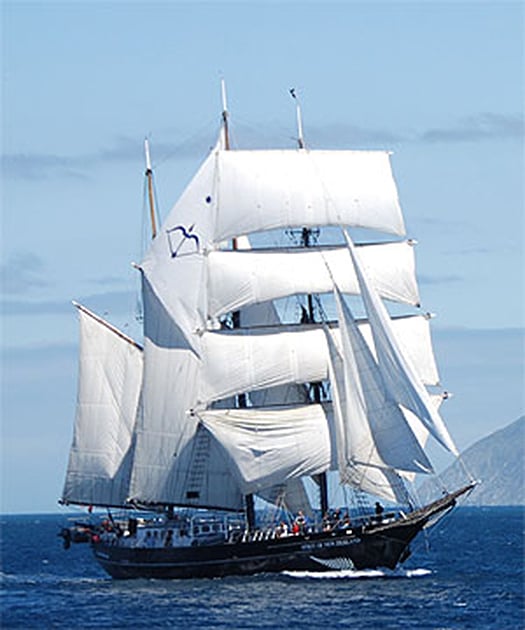
Spirit of New Zealand

Spirit of New Zealand almost seems like a vision of 1954 brought to life...

.....and that vision is Jack Tyrrell's 1954 concept for a 110ft sail training ship
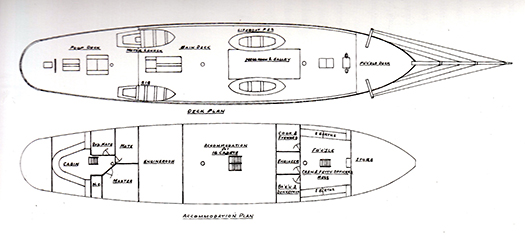
The 1954 accommodation drawings for the 110ft ship hark back to a more rugged age. Imagine the difficulties the ship's cook would face trying to get hot food from his galley on deck amidships all the way back to the officers in their mess down aft
We needn't necessarily agree with all the AYT's basic thinking For instance, they assert that Ireland is like New Zealand is being an isolated smallish island. It depends what you mean by "isolated". Those early sail training pioneers, the Vikings, certainly didn't think of Ireland as isolated. They thought it was central to the entire business of sailing up and down Europe's coastline.
Thus any all-Ireland sail training vessel would be expected to be away abroad at least as much as she'd be at home, whereas Spirit of New Zealand is usually home – the season of 2013-2014 was the first time she'd been to Australia since 1988, when she was in the fleet with Asgard II for the First Feet celebrations.
In New Zealand, she's a sort of floating adventure centre, and a large tender often accompanies her to take the trainees to the nearest landing place for shoreside adventures, for it's quite a challenge keeping 40 energetic young people fully occupied.
In Europe, that's where the sail training races come in. Time was when the racing aspect was down-played. But there's nothing like a good race to bring a mutinous crew together, and the recently-published mega-book about the world's sail training vessels, Tall Ships Today by Nigel Rowe of Sail Training International, quite rightly devotes significant space to everything to do with the racing.
Thus if we do get a new sail training ship for Ireland, she'll have to sail well and fast. That was Asgard II's greatest virtue. For there is nothing more dispiriting for troubled young folk than to find themselves shackled to the woofer of the fleet. Yet you'd be pleasantly surprised by how previously disengaged youngster can become actively and enthusiastically involved when they find that they're being transformed from scared and seasick kids into members of a winning crew.
So now, the 64 thousand dollar question. The cost. It's rather more than 64 thousand. AYT reckon they'll have to come up with a final capital expenditure of €15 million to build the ship and get her into full commission with proper crewing and shoreside administration arrangements in place. But after that – and here's the kernel of the whole concept – they reckon that the running costs will come out of existing government expenditure already in place and used every year for education, youth training, sporting facilities, social development and so forth.
So their pitch is that if the governments north and south come up with funding to support substantial donations already proposed for AYT by various benevolent national and international bodies, then once the ship is in being, she will generate her own income in the same way as vessels like Europa and Morgen Stern are already doing in mainland Europe.
And it's to the heart of mainland Europe that they'll be looking for design and contruction, as it's the Dykstra partnership which will be overseeing the design, and their ship-build associate company Damen will likely do the construction work, though one idea being floated is that Damen might provide a flatpack kit for the vessel to be built in steel in Ireland.
Those of us who dream of Asgard II being built anew will find all this a bit challenging to take on board. My own hopes, for instance, would still be to build Asgard II again to Jack Tyrrell's lines, but with the hull constructed in aluminium. It would be expensive as it would need to be double-skin below the waterline, but the ship's size would be very manageable with a professional crew of just five, while she'd sail like a dream And proper top-class marine grade aluminium seems to last for ever, as naval architect Gerry Dijkstra (his surname is slightly different from that of the partnership) himself shows with his remarkable cruises with his own-designed alloy 54-footer Bestevaer.
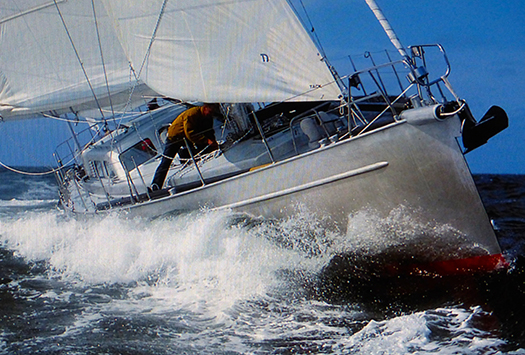
A man who knows what he's doing. This is Gerry Dijkstra's own extensively-cruised alloy-built 54 footer Bestevaer. The name translates not as "Best ever", but either as "best father" or "best seafarer", and was the name of affection given to the great Admiral de Ruyter by his loyal crews
Whatever, the good news is that things are on the move, and we wish them well, all those who have kept the Irish sail training flame alive through some appalling setbacks. Now, it really is the time to move forward. And if we do get a new ship, why not call her the Jack Tyrrell? He, of all people, was the one who kept the faith and the flame alive.
- Tall ship
- Belfast
- Jack Tyrell
- Kristiansand
- Aalesund
- Titanic
- maritime
- Class A
- square riggers
- George Stage
- Alexander Von Humboldt
- Christian Radich
- Sorlandet
- Shtandart
- Brigantine
- Asgard II
- Elaine Byrne
- Erskine Childers
- Sean Flood
- Naval
- Afloat magazine
- boatyard
- sail training ship
- Coiste an Asgard
- Charlie Haughey
- Colm Newport
- Irish Cruising Club
- Spirit of Oysterhaven
- Enda O'Coineen
- John Killeen
- Dykstra
#roundireland – Since 1980, the biennial 704-mile Round Ireland Race has been a cornerstone of Ireland's sailing programme. This year's fleet of 36 boats is good for the times that are in it, though it's still a far cry from the heady day of the 1990s when 54 boats came to the line. W M Nixon takes a look at the varied fleet for this 18th Edition of Ireland's Classic.
You wouldn't borrow money to go drinking with Enda O'Coineen on a Saturday night. But if you had to go into the jungle, or face up to a storm at sea, then he's a good man to have around. The intrepid Galwegian has been Irish sailing's gadfly for quite some time now. And more than occasionally, he has driven everyone else nuts - sometimes to the point of total exasperation - with his many cage-rattling schemes.
So his teaming-up for today's start on the Open 60 Teng Tools Kilcullen with Round Ireland Race super-veteran Eamon Crosbie is all of a piece for someone who crossed the Atlantic (at the second attempt) alone in a rubber dinghy, and was himself involved in two successful round Ireland record challenges.
It was the second of these records, in November (yes, November) 1986, which showed just what a cool and tough customer The Enda can be. The lumbering 83ft catamaran Novanet was making good progress on a clockwise circuit in a westerly wind north of Achill when the weather closed in with dark winter violence, a sudden cold front from north of northwest bringing ferocious hail squalls. Where they'd been comfortably clearing the sinister Black Rock off the coast of Mayo, now it was touch and go. Yet in the turbulent sea it was highly unlikely that the cumbersome big machine would be able to tack. The situation was dire, and one of the crew – a known millionaire – offered to buy the boat outright there and then if they'd run her up on a nearby beach.
The rest of them had to shout the options above the screams of the weather. But Enda wasn't saying a word. He just concentrated on taking running fixes of the painfully slowly changing bearing as the Black Rock light showed briefly through the squalls. "We're clearing it," he said quietly. "But by how much?" roared the would-be boat purchaser. "We're clearing it, just keep her going" was all that Enda would reveal.
To this day, nobody knows by precisely how much they did clear the rock on that November evening. It wasn't a lot, and might only have been a few feet. But clear it they did, and within 24 hours Novanet had completed her circuit and the new record stood until September 1993, when Steve Fossett with the 60ft trimaran Lakota established the astonishing record which still stands today.

The lumbering giant.....Enda O Coineen's cool pilotage of the 83ft catamaran Novanet on a stormy November night in 1986 saw her safely past the Black Rock in Mayo, and a new Round Ireland Record next day.
It's unlikely that there'll be any record breaking by the fleet going off this afternoon. For record-breaking purposes, it's best to see Ireland as a sort of green lozenge on a northeast/southwest axis, which means that any serious record-breaking attempt will hope to have a steady period of either nor'westers or sou'easters to give it a head start.
So the forecast of a nor'easter today may indeed send the fleet away in style. But the prospect of a long light airs beat up the west coast as the incoming high pressure builds will make the race a test of patience, and it will be a matter of getting to the finish eventually (and still talking to each other), rather than shaping up for a record.
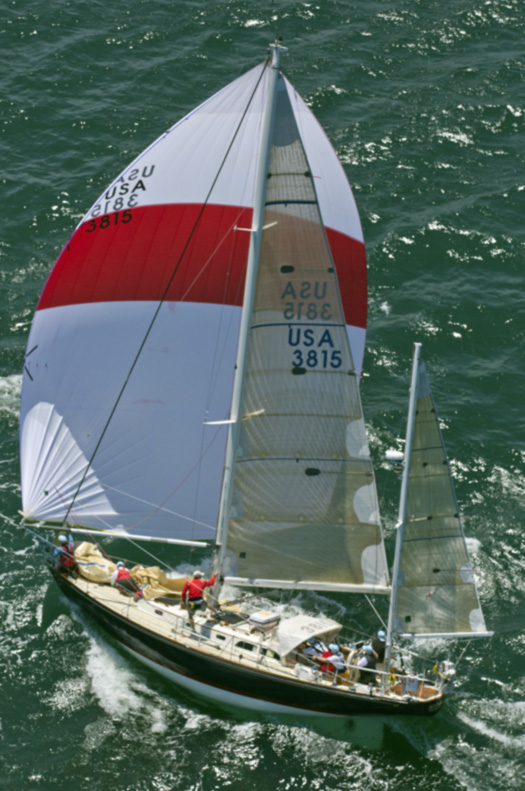
The Hinckley 40 Actaea (Michael Core), a comfortable cruiser-racer which yesterday was declared overall corrected time winner of the biennial 635-mile Bermuda Race. Photo: Daniel Forster
There doesn't seem to be a lot of wind about anywhere in the North Atlantic just now, as America's biennial 635-mile Newport-Bermuda Race has been very slow-sailed this past week since starting on Friday June 20th. For long stages, the best progress was being made by boat which got themselves into the most favourable eddies of the Gulf Stream, which in one location were the equivalent of a fair tide of 2 knots plus. Such conditions favour the lowest-rated most comfortable cruising style boats. So although the mini-maxi Shockwave took line honours, the corrected times were something of a shockwave in themselves, as the overall winner was Michael Core's well-sailed classic Hinckley Bermuda 40 yawl Actaea .
The Round Ireland fleet includes two boats of the same fairly hefty type as Actaea, and even without the news from Bermuda (where the Dark 'n Stormies are being consumed apace), both Ian Hickey's Granada 38 Cavatina from Cork and Brian O'Sullivan & Frances Clifford's Oyster 37 Amazing Grace from Tralee, were already highly favoured in the betting. Cavatina has been in the frame – including overall win – in several Round Irelands, while Amazing Grace celebrated her inauguration in the O'Sullivan/Clifford ownership last year by winning the Dun Laoghaire-Dingle overall after the wind taps had been turned off.
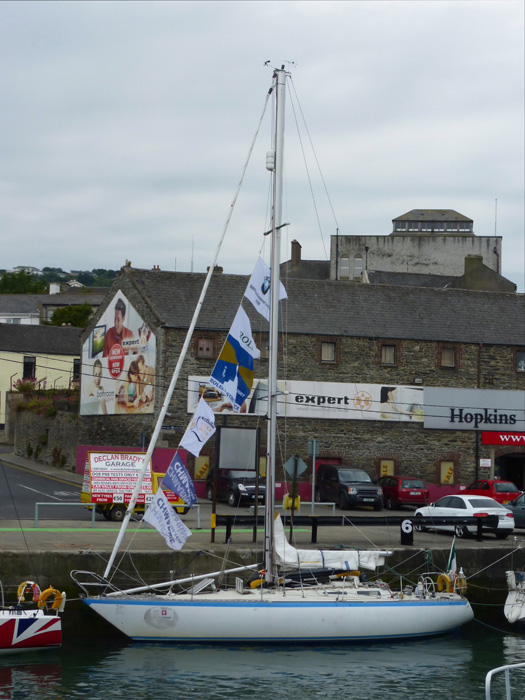
Cavatina in Wicklow on Thursday, with battle flags which reflect her distinguished career. Photo: W M Nixon
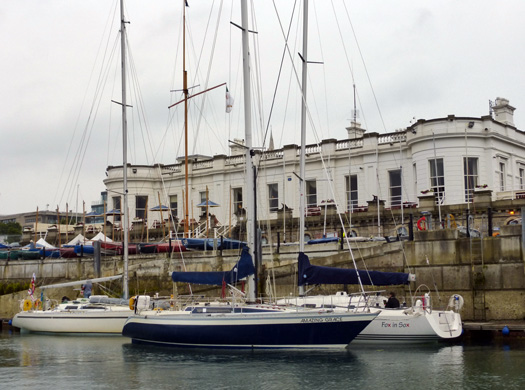
Amazing Grace at the Dun Laoghaire base of the Round Ireland Race at the Royal Irish YC on Thursday. Last year, light winds in the middle stage of the Dun Laoghaire-Dingle Race set up a pattern which provided overall victory for this Tralee Bay boat. Photo: W M Nixon
With Cavatina rated at only 0.922 and Amazing Grace just a little higher at 0.928, they're piling up the advantage just sitting still. But two boats rate even lower. These are the Dehler 34 Big Deal from Foynes, raced by the Listowel father-and-son team of Derek & Conor Dillon in the two-handed division, and the Isle of Man Sigma 33 Manx Polish (Kuba Szymanski) which clocks in at just 0.898, and has impressed with her showing in ISORA racing in recent years.
The smallest boat of all is not the lowest rated. The tiddler of the fleet - just scraping in over the 30ft LOA lower limit - is Ian Patterson's North Channel 9m Wildwood from East Antrim Boat Club in Larne. Having a build date of 2012 makes Wildwood one of the newest boats in what is admittedly a fleet of veteran vessels, but "2012" is a bit notional, as this amateur-build project has taken nine years. But she certainly looks the business, and as a plucky effort, she's in a league of her own.
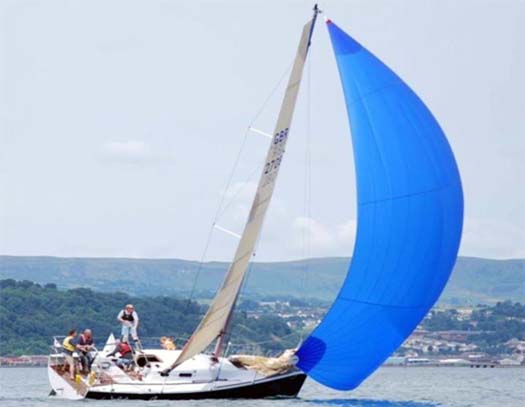
From East Antrim Boat Club at Larne, Wildwood (Ian Patterson) is a remarkable self-build project, and at just 30.5ft LOA, she is the smallest boat in the Round Ireland Race. Photo courtesy WSC
Being very much performance-oriented, Wildwood sails off a rating of 1.02, which puts her well above one of the fancied boats in the two-handed division, Kirsteen Donaldson's Solent-based X 332 Pyxis, rating at just 0.957 and a noted peformer in short-handed racing. Pyxis is just one of many entrants from the RORC heartlands around the English Channel, attracted both by the special challenge of the Round Ireland Race, and by the bonus of the points being weighted 1.4 in the RORC Championship.
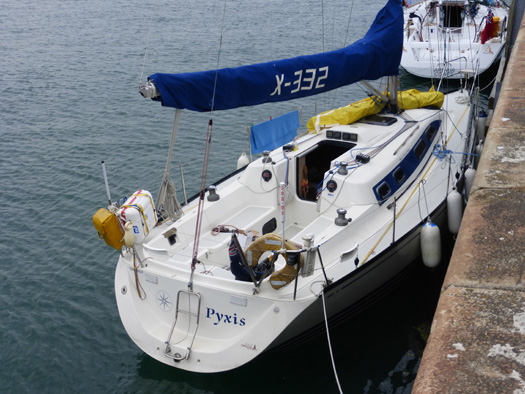
"We're here, and we're going to give it our best shot". Kirsteen Donaldson's X 332 Pyxis is a noted performer in short-handed racing in the English Channel, and was one of the first boats to arrive in Wicklow before the start. Photo: W M Nixon
With the weather forecasts indicating a sou'wester starting to reach the western seaboard by Tuesday evening, the smaller boats which can stick at it will inevitably be favoured. But the best modern offshore racers can be sailing up to their ratings with remarkably little wind, so the likelihood of another excellent overall performance by Laurent Gouy's Ker 39 should never be discounted. And the quality of the boats in the middle of the fleet is notably high, with two J/109s – Liam Shanahan's Ruth from the National, and Peter Dunlop and Viv Cox's Mojito from Pwllheli – having their performance sharpened by shaping up to Frank Doyle's similarly-rated A35 Endgame from Crosshaven.
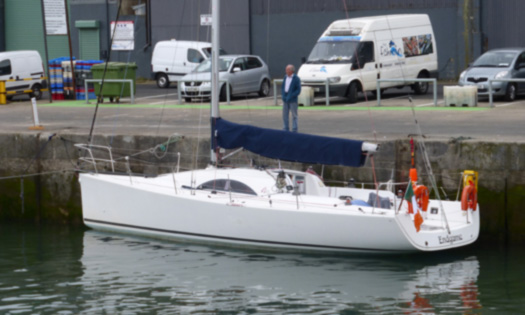
Frank Doyle's slippy A35 Endgame from Cork in Wicklow Harbour, where his father Denis began many successful Round Ireland Races with the powerful Frers 51 Moonduster........ Photo: W M Nixon
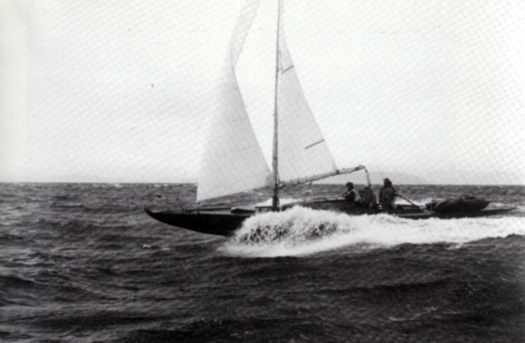
.....but it shouldn't be forgotten that Denis Doyle's offshore racing career began with the hyper-slim 30 Square Metre Vanja IV
The continuation of the name of Doyle of Cork in the Round Ireland annals is a source of special satisfaction to Peter Shearer and his team of organisers in Wicklow, as Frank's father Denis was a stalwart of the race with his Frers 51 Moonduster from 1982 until 2000. And while Moonduster may seem a memory of traditional seagoing strength by comparison with the hyper-light Endgame, never forget that Denis himself started his offshore racing with the 30 Square Metre Vanja IV, which was very austere indeed.
With each new edition, the Round Ireland Race sees increasing involvement by offshore sailing schools offering newcomers to the sport the complete introductory package, with the Round Ireland "medal" in their sailing CV at the end of it. There are several school, club and association challenge boats in the mix this year, a classic example being Irish Offshore Sailing of Dun Laoghaire's campaign with the Jeanneau Sunfast 37 Desert Star. Aboard DS, skipper Ronan O'Siochru finds himself in command of a truly multi-national and multi-cultural crew including professions as diverse as IT specialists, bakers and biochemists, and from several nationalities too – this is modern Ireland goes sailing and then some.
But inevitably, while most of the fleet will be focused on the corrected time win, line honours is where the glamour is to be found. Wicklow farmer David Ryan has leapt into the fray by chartering a Volvo 70 veteran of the 2008-2009 Volvo World Race, the Rob Humphreys-designed Russian boat which now sails the seas as Monster Project.
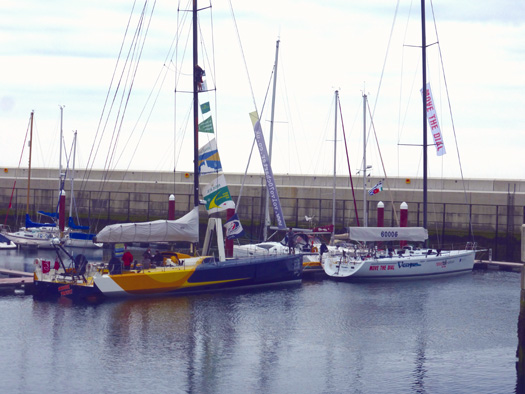
"Greystones has never seen the like of it". Heavy metal in the new County Wicklow marina, with the David Ryan-chartered Volvo 70 Monster Project, and ahead of her Joe McDonald's Farr 60 NewsTalk for Adrenalin. Photo: W M Nixon
The organizational effort involved in running the Round Ireland Race is so great for a small club like Wicklow that in some years WSC don't have an entry to call their own. But Farmer Ryan has blown this out of the water with this mighty boat, which will race with a crew of 18. So totally is this a Wicklowcentric campaign that, although the boat couldn't be berthed in Wicklow Harbour itself, she set up base camp in Greystones where the new marina came to life as another big Round Ireland contender, Joe McDonald's very handsome Farr 60 NewsTalk for Adrenalin, was also in port.
But meanwhile down in Wicklow some determined souls made sure the organising club had some presence beforehand, and both Open 40s – Kevin Rolfe's May Contain Nuts and Austin Clark's Arwen – were there on the outer pier, alongside which there also sat the vintage Volvo Ocean Team Jolokia from Lorient in France, now looking like a bit of maritime history, but a gallant performer nevertheless.

The two Open 40s at Wicklow could not have been more different in their hull style than the veteran Volvo Ocean 60 Jolokia from South Brittany (below). Photos: W M Nixon

All the special boats and everything above 55ft will be aiming at the line honours prize, and in the Teng Tools Kilcullen challenge we see a formidable project. The linkup between Enda O Coineen and Eamon Crosbie goes right back to the late great Jim Poole. Eamon was Jim's crew in the two-handed three-stage Round Ireland Race from Ballyholme in 1975, and Enda was in the strength on Jim's Half Tonner Feanor when she won IOR overall in the first Wicklow Round Ireland in 1980.
Since then, Eamon has become part of the round Ireland racing story with his successes with the Ker 32 Voodoo Chile, while Enda's seaborn interests are diverse and absorbing. But for both of them, this linkup in the chartered Open 60 Artemis represents enough new ground for fresh excitement, while continuing to utilize their unrivalled experience.
They've decided to race with a total crew of seven, including metman/routing expert/Open 60 veteran Wouter Verbak. The other four in addition to the joint skippers are Mark McGibney, Andy Greenwood, Greg Parker and Alan Crosbie, the latter fresh from sailing on Quest, the overall winner of the ICRA Nats.
It's undoubtedly a crew of all the talents, and if the weather performs as expected, at 1400 hrs today we can expect to see the likes of Monster Project and Teng Tools Kilcullen streaming away from Wicklow in formidable style while the smaller boats bob in their wakes. But as many who have raced round Ireland or indeed just cruised round will know, the Atlantic seaboard can seem to be one very long bit of coastline when the wind is light from ahead. For little boats, knowing there are sou'westers advancing slowly from the ocean, it may well be a case of everything coming – and coming right – for those who wait.
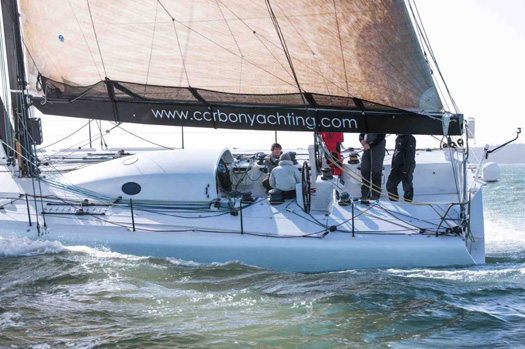
Teng Tools KIlcullen is being sailed by one of the most talented crews in the Round Ireland Race 2014.
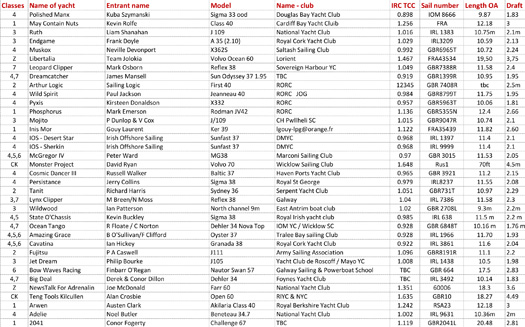
Round Ireland Entry list 2014

































































